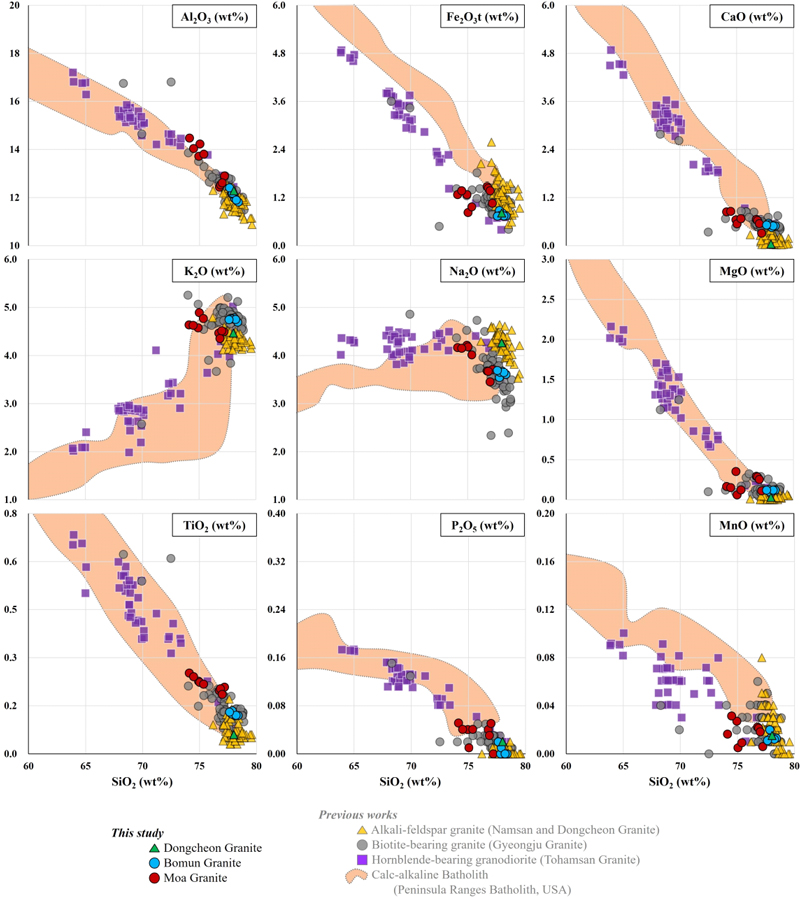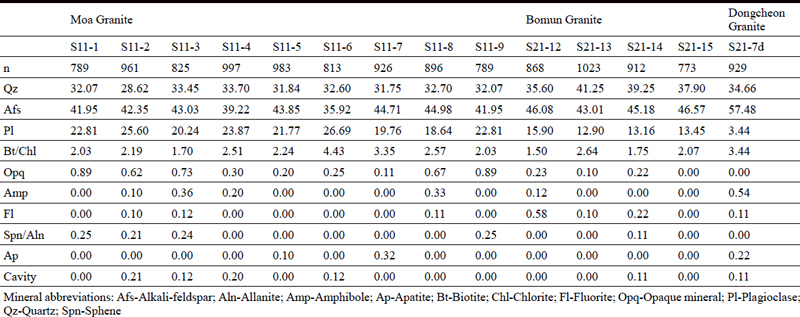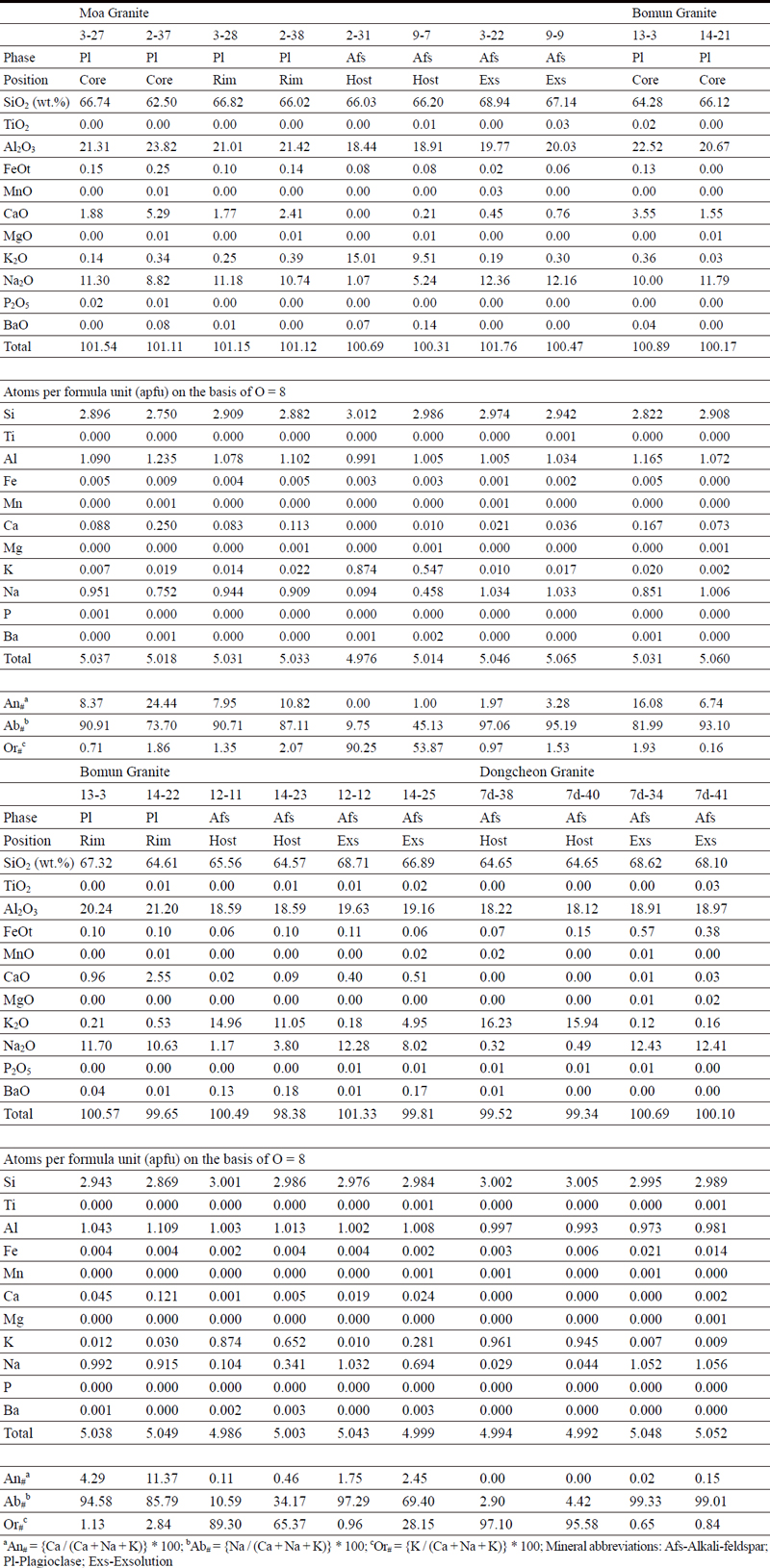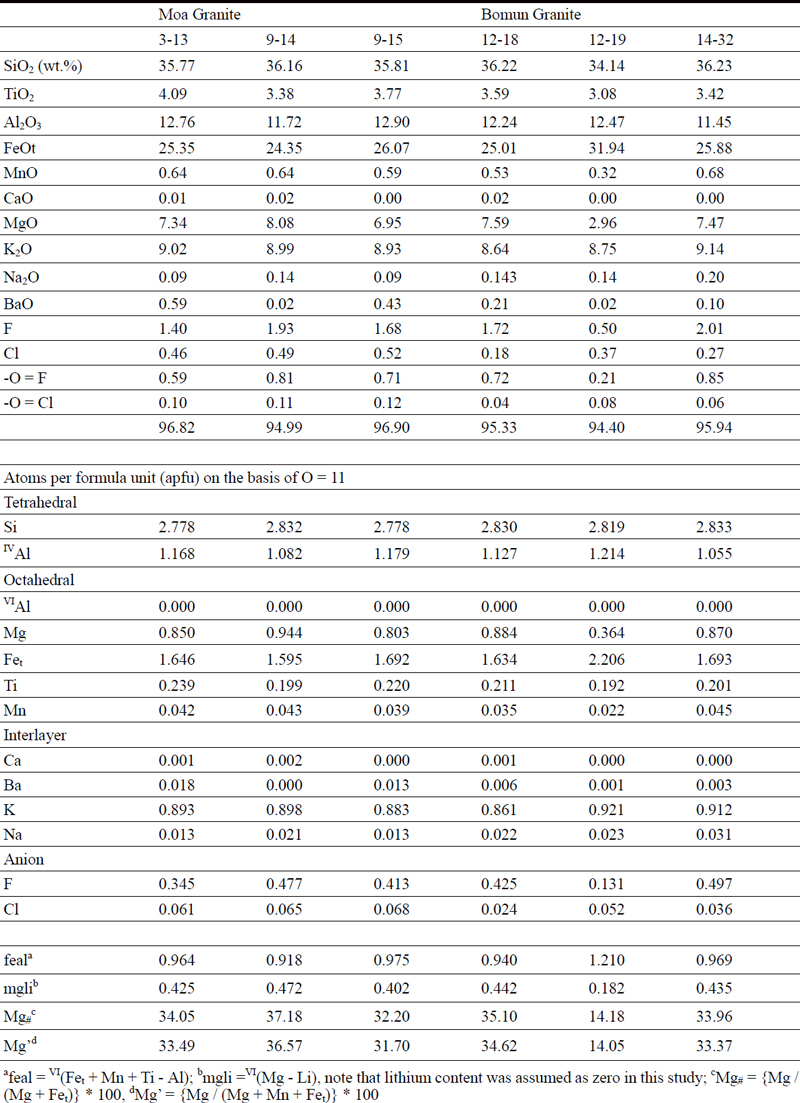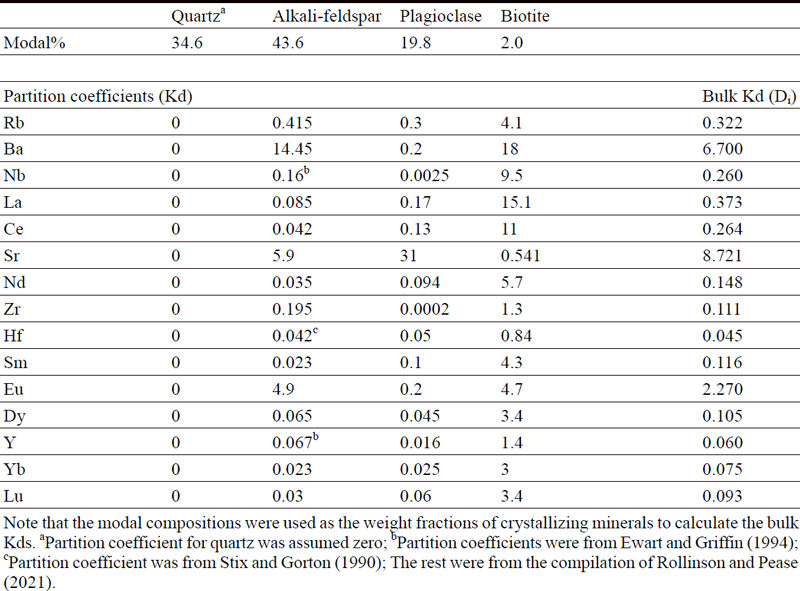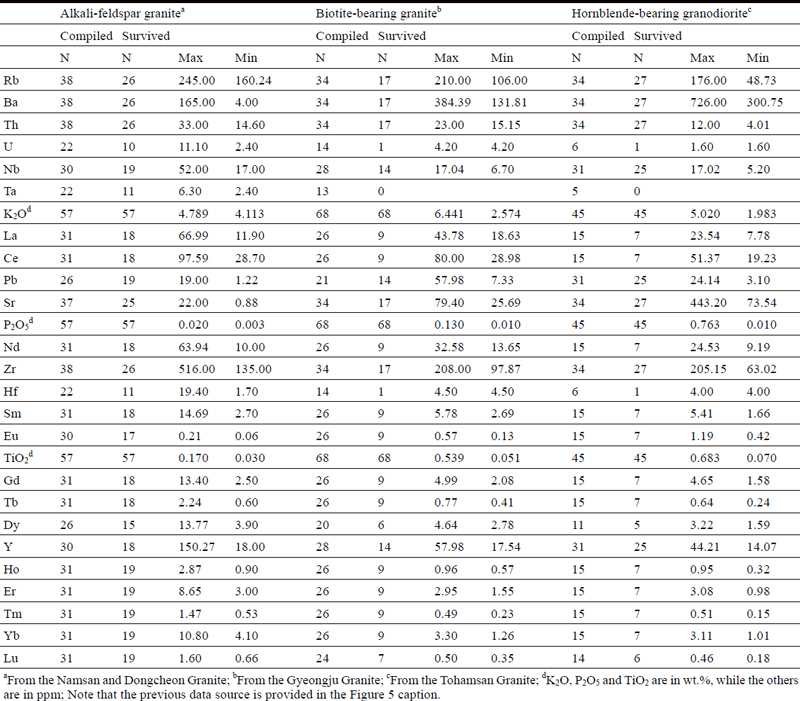
규장질 누적암과 용융체의 불완전 분리를 통한 고-실리카 화강암의 형성에 대한 예비연구: 경주 일대 양산단층 동부의 우백질 화강암
초록
화강암질 결정죽은 규장질 누적암과 간극상 용융체로 구성되며, 따라서, 화강암의 지구화학적 전암 조성은 누적암과 용융체의 비율에 따라 결정된다. 이번 연구는 경주 일대 양산단층 동부를 접촉하며 산출되는 흑운모 화강암(모아 및 보문화강암)과 알칼리장석 화강암(동천화강암)을 형성한 화강암질 결정죽의 조성적 진화가 지구화학적 지시자를 활용한 지구조적 해석에 끼칠 수 있는 영향에 대한 사례를 제공한다. 연구지역 일대의 화강암질 암석은 모드조성에 따라 몬조화강암-섬장화강암-알칼리장석 화강암의 영역에 도시되는 우백질 화강암이다. 장석류와 흑운모는 흑운모 화강암에서 알칼리장석 화강암으로 점차 진화된 광물화학조성을 보인다. 흑운모 화강암과 알칼리장석 화강암은 74-78 wt.% 전암 SiO2 함량을 가지는 고-실리카 화강암이며, 전체적으로 마그네시안 메타알루미너스에서 페로안 퍼알루미너스 칼크-알칼릭 계열을 통해 연속적으로 진화한다. 주성분원소 및 미량원소 특성은 연구지역의 화강암질 암석이 화산호 천부지각에 발달한 결정죽의 고화 산물임을 시사한다. 분별정출 모델을 바탕으로, 흑운모 화강암과 알칼리장석 화강암은 각각 규장질 누적암이 우세한 결정죽 그리고 결정죽에서 추출된 용융체로 해석되었다.
Abstract
Granitic crystal mush consists of felsic cumulate and interstitial melt. Thus, the whole-rock compositions of fully crystallized granite depend on the proportions of cumulus felsic minerals and interstitial melt. Here, we (1) report the petrographic and whole-rock major and trace element elements characteristics of the Moa, Bomun and Dongcheon Granite occurring at the eastern contacts of the Middle Yangsan Fault, South Korea and (2) provide a case that the geochemical proxies used in tectonic discrimination may reflect felsic cumulate-melt separation rather than tectonic setting where the granites formed. Granitic rocks in the study area are subdivided into biotite granite (Moa and Bomun Granite) and alkali-feldspar granite (Dongcheon Granite). They are leucocratic monzogranite-syenogranite-alkali-feldspar granite on the basis of modal compositions. Feldspars and biotite in the alkali-feldspar granite have more evolved composition than those in the biotite granite. These leucocratic granites have extremely high silica contents (74-78 wt.%), showing a continuous calc-alkalic trend evolving from the magnesian metaluminous to ferroan peraluminous fields. The major and trace element elements characteristics suggest that the leucocratic high-silica granites are a product of granitic crystal mush in the shallow volcanic-arc crust. Our fractional crystallization models indicate that the biotite granite is felsic cumulate-dominant part whereas the alkali-feldspar granite is frozen melt extracted from the crystallizing mush.
Keywords:
granite, crystal mush, felsic cumulate, melt extraction키워드:
화강암, 결정죽, 규장질 누적암, 용융체 추출1. 서 론
활화산의 지하에서 수 km 규모의 지진파 저속도 영역이 관찰되지 않는다는 점은 지각 내의 마그마 저장고(magma reservoir)가 결정과 용융체(melt)가 혼합된 결정죽(crystal mush) 상태로 존재한다는 점을 시사한다(e.g., Bachmann and Huber, 2016; Cashman et al., 2017; Sparks et al., 2019). 고화대(solidification fronts)는 감소하는 온도 그리고 그에 따라 증가하는 결정의 부피비(vol.%)에 따라, 부유대(suspension zone, <25 vol.%), 포획대(capture front, ~25 vol.%), 결정죽(~25-~50 vol.%) 그리고 강체지각(rigid crust, ~50-100 vol.%)으로 구성되며, 이때 간극상 공간은 용융체로 채워진다(Marsh, 2002). Irvine (1982)은 누적암(cumulate)을 서로 접촉하는 광물들이 구성하는 누적상 결정망(cumulus framework)을 가지는 화성암으로 정의했으며, 이는 반려암 뿐만 아니라 화강암 역시 누적암으로 여겨질 수 있는 개념적 배경이 되었다(e.g., Bachmann and Bergantz, 2004; Chappell and Wyborn, 2004; Vernon and Collins, 2011; Lee and Morton, 2015; Schaen et al., 2018; Barnes et al., 2019). 따라서, 고화대 내에서 결정/용융체 비율이 높은 부분은 지구화학적으로 누적암에 가까운 특성을 가지며, 그 비율이 낮은 부분은 용융체에 가까운 특성을 가진다(e.g., Deering and Bachmann, 2010; Lee and Morton, 2015; Barnes et al., 2019).
화강암질 마그마는 다양한 지구조적 환경에서 형성될 수 있으며, 이들은 서로 구분되는 미량원소 조성을 가진다(e.g., Pearce et al., 1984; Pearce, 1996). 이러한 특성을 바탕으로 국내 화강암 연구는 넓은 지역에 분포하는 화강암의 U-Pb 저어콘(zircon) 연령과 전암조성을 이용한 조구조판별도를 통해 한반도의 지구조적 진화를 이해하는데 크게 기여하고 있다(e.g., Kim et al., 2011, 2016; Cheong and Jo, 2017; Jo et al., 2018; Cheong et al., 2023). 이때 두 가지 가정이 사용된다: (1) U-Pb 저어콘 가중평균연령은 화강암의 정치(emplacement) 시기로 가정된다. 하지만, 결정죽 내부에 불규칙적으로 분포하는 간극상 용융체 저장고(interstitial melt reservoir)에서 수 Myr에 걸쳐 저어콘이 지속적으로 결정화될 수 있다(e.g., Schaen et al., 2017; Chen et al., 2023; Lim et al., 2024). 따라서, 형성과정에 따른 결정군집(i.e., crystal population; Jerram and Martin, 2008; Zellmer, 2021)이 고려되지 않은 U-Pb 저어콘 가중평균연령은 화강암의 정확한 정치시기를 지시하기 어렵다. 게다가, (2) 화강암의 전암조성은 결정집적(crystal accumulation)의 영향이 없는 용융체의 조성으로 가정된다. 하지만, 화강암은 규장질 누적상 결정망과 간극상 용융체가 다양한 비율로 혼합된 채 고화된 산물이다(e.g., Deering and Bachmann, 2010; Lee and Morton, 2015; Schaen et al., 2017; Barnes et al., 2019). 따라서, 조구조판별도 상에서 나타나는 결정누적의 영향이 고려되어야 한다.
한편, 화강암질 결정죽에 대한 연구는 누적암 그리고 간극상 용융체 각각의 조성적 진화에 대한 정보를 줄 수 있으며(e.g., Deering and Bachmann, 2010; Schaen et al., 2017; Chen et al., 2023), 이는 저어콘의 형성과정 뿐만 아니라 암상 간의 조성적 차이에 대한 보다 자세한 고찰을 가능케한다. 이러한 맥락에서 화강암을 형성한 결정죽의 조성적 진화에 대한 연구가 국내에 도입될 필요 있다. 이번 연구는 경주 일대 양산단층 동편에 인접하여 산출되는 암주상 화강암에 대한 암석기재, 광물화학 그리고 전암화학 특성을 보고한다. 또한, 인근에 분포하는 불국사화강암(토함산화강암, 경주화강암 그리고 남산화강암)에 대해 보고된 기존의 전암화학조성을 종합 및 평가하였고, 이를 이번 연구의 결과와 비교하였다. 이번 연구는 화강암질 결정죽의 조성적 진화가 전암화학조성을 활용한 지구조 해석에 끼칠 수 있는 영향에 대한 사례를 제공한다.
2. 지질개요
동해안을 따라 울산-경주-포항에 분포하는 신생대 퇴적분지를 제외하고, 지체구조상 한반도 남동부는 후기 백악기 하성 및 호성 퇴적물로 채워진 경상분지에 해당된다(그림 1a; e.g., Chough and Sohn, 2010; Lee et al., 2018; Choi and Kwon, 2019; Chae et al., 2021). 경상분지의 퇴적암은 경상누층군으로 통칭되며, 그 층서는 하부에서 상부 층준을 향해 화산쇄설성 물질이 증가함에 따라 신동층군, 하양층군 그리고 유천층군으로 세분된다(e.g., Chang, 1975). 후기 백악기 말-신생대 올리고세 유라시아판 북동부에 발달한 화산호를 따라 다량의 화강암질 대륙지각이 형성되었다(e.g., Jo et al., 2016; Kim et al., 2016; Cheong and Jo, 2017; Wu and Wu, 2019; Cheong et al., 2023). 이 시기에 상응하는 한반도의 화강암질 암석은 불국사화강암으로 명명되며, 관입 당시 10 km 이하의 천부지각에 정치했다(그림 1a; e.g., Kim, 1971; Cho and Kwon, 1994; Jwa, 1996; Koh et al., 2000; Kim et al., 2016).
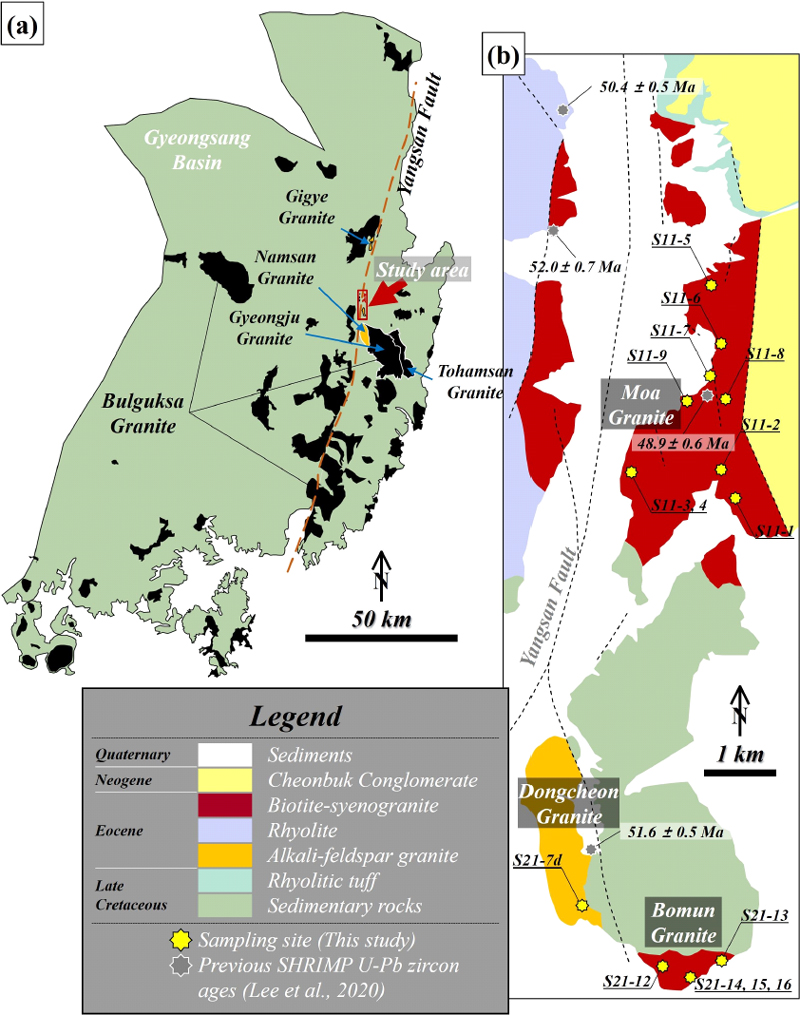
(a) Distribution of the Bulguksa Granite in the Gyeongsang Basin (modified from Chough and Sohn, 2010; Kim et al., 2016; Cheong and Jo, 2017). The dashed line indicates a trace of the Yangsan Fault. The narrow arrows represent some granitic bodies used for comparison. Study area is indicated as the red box with thick arrow. (b) The geological map of study area (modified from Lee et al., 2020).
경주 일대에 분포하는 불국사화강암은 모드(mode) 조성에 따라 섬록암-화강섬록암-화강암-알칼리장석 화강암으로 분류되며(e.g., Lee et al., 1995; Koh, 2001; Hwang, 2004), 지구화학적으로 칼크-알칼라인(calc-alkaline) 계열을 따라 진화한다(e.g., Jwa, 1996; Kim et al., 2016; Cheong and Jo, 2017). 이들은 암질과 SHRIMP(sensitive high resolution ion microprobe) U-Pb 저어콘 가중평균연령에 따라 크게 토함산화강암(i.e., 각섬석 화강섬록암, 57.5 ± 0.5, 56.8 ± 0.9 Ma), 경주화강암(i.e., 흑운모 화강암, 53.9 ± 0.4 Ma) 그리고 남산화강암(i.e., 알칼리장석 화강암, 54.4 ± 0.4, 51.3 ± 0.8 Ma)으로 구분된다(그림 1a; Cheong et al., 2013; Jo et al., 2016; Cheong and Jo, 2017; Lee et al., 2020). 전암 εNd(t) 및 저어콘 εHf(t) 조성의 진화를 바탕으로 경상분지 내부에 분포하는 불국사화강암의 모마그마는 페름기-쥬라기 화강암(e.g., 영덕화강암)의 재용융을 통해 형성된 것으로 해석되었다(Jo et al., 2016; Cheong and Jo, 2017). 한편, 대략 55 Ma 보다 어린 연령을 가지는 불국사화강암(e.g., 남산화강암)은 55 Ma 보다 오래된 화강암보다 높은 저어콘 εHf(t) 그리고 낮은 δ18O 값을 가지며, 이러한 특징은 55 Ma 보다 젊은 시기의 모마그마에 연약권 맨틀의 성분 그리고 열수 변질을 경험한 지각물질이 유입된 결과로 해석되었다(Jo et al., 2016; Cheong and Jo, 2017).
양산단층은 북북동-남남서 방향으로 200 km 이상의 연장성을 보이며, 수평적으로 수 km 이상의 단층대를 가지며 그리고 수직적으로는 암석권 맨틀까지 연장된다(그림 1a; Lee, D.H. et al., 2016; Cheon et al., 2019; Lee, H. et al., 2019; Lee, S.R. et al., 2020). 양산단층은 부산-양산-경주-포항-영덕 일대에 분포하는 불국사화강암을 다양한 규모로 절단한다(e.g., Cheon et al., 2019). 특히 경주-포항 일대에 떨어져 분포하는 알칼리장석 화강암의 암석학적 특징 및 U-Pb 저어콘 연령의 유사성을 근거로(Hwang et al., 2012; Jo et al., 2016; Cheong and Jo, 2017), 양산단층이 대략 20 km의 최종 우수향 수평변위를 가진다는 점이 제안된 바 있다(Hwang, 2004; Hwang et al., 2007, 2012; Cheon et al., 2019).
연구대상은 경주 일대에서 양산단층과 인접하여 동편에 분포하는 암주상 화강암이다. 모아화강암(그림 1b; 48.9 ± 0.6 Ma; Lee et al., 2020)은 양산단층 동편에서 하양층군 퇴적암 및 유천층군 유문암질 용결응회암(66.4 ± 0.2 Ma; Lee et al., 2020)을 관입하며, 암체의 동쪽 경계는 단층을 따라 천북역암에 의해 피복된다. 한편, 보문화강암은 연구지역 남부에서 하양층군을 관입하고 있다. 동천화강암(그림 1b; 51.6 ± 0.5 Ma; Lee et al., 2020)은 하양층군을 관입하는 알칼리장석 화강암이며, 남산 및 기계 지역의 알칼리장석 화강암과 유사한 지구화학적 특성을 가진다(그림 1a; Myeong et al., 2017).
3. 연구방법
모아, 보문 그리고 동천화강암에 대해 각각 9, 5 그리고 1개의 시료를 채취하였다. 모든 시료를 연마박편(polished thin section)으로 제작하였으며, 점셈법(point counting)을 통해 이들에 대한 모드 분석을 실시하였다(표 1). 결정의 크기와 추측되는 성인에 따른 명명은 Zellmer (2021)가 제안한 정의를 따른다.
시료의 후방산란전자(back-scattered electron; BSE) 이미지와 구성광물들의 정량적인 화학조성을 얻기 위해, 경북대학교 공동실험실습관에 설치된 전계방사형 전자탐침미세분석기(field emission electron probe micro analyzer; FE-EPMA, JEOL JXA-8530F)를 사용하였다. 연마박편의 표면은 탄소(C)로 코팅하였다. 이번 연구에서 채택된 파장분산분광(wavelength dispersive spectrometry) 분석 조건은 다음과 같다: 가속전압 15 kV, 탐침전류 10 nA, 탐침크기 5 um, 피크측정 20s 그리고 배경값 측정 10s. 얻어진 데이터에 대해 ZAF(atomic number-absorption-fluorescence) 보정을 실시하였다. 분석치는 전체적으로 3 wt.% 이상의 함량을 보이는 산화물에 대해 5% 미만의 오차를 가진다. 이번 연구에서 획득된 장석류 및 운모류 광물화학 조성은 각각 표 2와 3에 요약되어 있다.
박편을 제작하고 남은 암석칩을 유압파쇄기를 사용하여 수 mm 크기로 파쇄하고, 이를 다시 증류수로 세척하였다. 변질된 부분은 수선별(hand-picking)하여 제거하였다. 60℃ 오븐에서 시료를 24시간 동안 건조한 후, 텅스텐 카바이드 볼밀(W-carbide ball mill) 및 아게이트(agate) 막자사발을 사용해 분쇄하였다. 전암 주원소 및 미량원소 조성은 캐나다 Activation laboratories(Actlabs)에서 분석되었다. Actlabs는 알칼리용융을 통해 분말화된 시료를 비드(bead)로 만들고, 이를 질산으로 용해하여 전처리를 수행하였다. 이러한 용해방식은 일반적인 질산용해보다 저어콘과 스핀(sphene) 같은 불용성광물을 녹이는데 유리하다(e.g., Choi et al., 1994). 주성분원소를 포함한 일부 미량원소(Sc, V, Ba, Sr, Y and Zr)의 조성은 유도결합플라즈마(inductively coupled plasma; ICP)-광방출분석법(optical emission spectrometry)을 통해 획득되었다. 나머지 미량원소의 조성은 ICP-질량분석법(mass spectrometry)를 통해 분석되었다(표 4). 전암화학 분석치의 상태를 검증하기 위해 국제표준지질시료가 함께 분석되었다(표 4). 주원소 및 미량원소는 각각 대략 3% 그리고 10% 이내의 오차를 가진다.
4. 결 과
4.1 암석기재
연구지역에 분포하는 화강암질 암석은 모두 5 modal% 미만의 고철질 광물을 포함하는 우백질(leucocratic; Le Maitre et al., 2002) 암석이다(그림 2; 표 1). 모든 암체에서 미아롤리틱 정동(miarolitic cavity)이 불규칙한 분포로 산출되며, 이들은 3 cm 미만의 장경을 가지는 타원 또는 간극상 형태로 관찰된다(그림 2a-c). 연구지역의 화강암질 암석은 주로 알칼리장석(36-57 modal%), 석영(29-41 modal%), 그리고 사장석(3-27 modal%)으로 구성되며, 흑운모(1-4 modal%)를 부구성광물로 포함한다(표 1). 미량광물은 불투명광물(주로 Fe-Ti 산화물), 형석, 스핀, 갈렴석, 각섬석, 인회석, 모나자이트(monazite) 그리고 저어콘을 포함하며, 이들은 모두 1 modal% 미만의 모드조성을 가진다(표 1).

The occurrence of (a) Moa, (b) Bomun and (c) Dongcheon Granite and (d) The QAP classification (Le Maitre et al., 2002) based on the modal compositions in Table 1. Previous modal compositions are from Lee et al. (1995), Koh et al. (1996), Lee and Hwang (1999) and Koh (2001). Abbreviations: AFG-Alkali-feldspar granite; SG-Syenogranite; MG-Monzogranite; GD-Granodiorite.
모아화강암은 모드조성상 몬조화강암 내지 섬장화강암으로 분류된다(그림 2d). 알칼리장석은 1-5 mm 장경의 반자형 결정으로 관찰되며, 퍼사이트 조직을 가진다(그림 3a). 이들은 독립된 반정(macrocryst; 500 um-10 mm; Zellmer, 2021)으로 산출되거나, 또는 사장석 위에 과성장된 채로 관찰된다(그림 3a). 석영은 골격상(skeletal) 성장구조를 보이는 반자형 결정으로 관찰되며(그림 3a, 3b; e.g., Barbee et al., 2020), 1-5 mm에 걸쳐 간극을 따라 성장 되어있다. 사장석은 1-3 mm 자형 내지 반자형 반정으로 관찰되거나, 취반상(glomeroporphyritic) 내지 집적체(aggregates)로 관찰된다(그림 3a). 사장석은 대부분 점진적 정-진동누대를 가진다.

Petrography of (a and b) the Moa Granite, (c and d) Bomun Granite and (e and f) Dongcheon Granite and (g and h) their accessory minerals. (a), (b), (c) and (e) are cross-polarized light images. (d), (f) and (h) are back-scattered electron (BSE) images. The upper half of (f) is energy-dispersive spectrometric (EDS) Na ka-mapping result. (g) is an EDS phase map for accessory phases. The red arrows represent alkali-feldspar overgrowth on the plagioclase antecrystic core. The blue arrows indicate a skeletal growth of quartz crystals. Note that the contacting relationships of euhedral to subhedral crystals are observed as plagioclase in (a) and alkali-feldspar in (c). Abbreviations (Whitney and Evans, 2010): Ab-Albite; Afs-Alkali-feldspar; Ap-Apatite; Arf-Arfvedsonite; Or-Orthoclase; Pl-Plagioclase; Qz-Quartz; Spn-Sphene; Thr-Thorite; Zrn-Zircon.
보문화강암은 모드조성상 섬장화강암으로 분류된다(그림 2d). 알칼리장석은 1-5 mm 장경의 자형 내지 반자형 반정으로 산출되며, 부분적으로 결정 간 접촉관계가 확인된다(그림 3c). 이들은 모두 간극을 따라 과성장되어 되어 있고(그림 3c), 결정 내부에 퍼사이트 조직을 가진다(그림 3d). 석영은 골격상 성장구조를 보이는 반자형 반정 내지 타형 결정으로 관찰되며, 간극을 따라 1-3 mm에 걸쳐 과성장 되어 있다(그림 3c). 사장석은 자형에서 반자형의 반정 내지 준반정(mesocryst; 100-500 um; Zellmer, 2021)으로 산출되며, 점진적 정-진동누대를 가진다(그림 3c, 3d). 보문화강암의 사장석(그림 3d)은 산출빈도, 크기 그리고 조직적 측면에서 모아화강암의 사장석(그림 3a)과 구분된다.
동천화강암은 모드조성상 알칼리장석 화강암에 해당된다(그림 2d). 1-4 mm 크기를 가지는 자형 내지 반자형 알칼리장석이 서로 접촉하여 관찰된다(그림 3e). 이들은 모두 결정 내부에 퍼사이트 조직을 가지며, 알칼리장석 결정의 경계부에 알바이트(albite) 아입자(subgrain)가 집중되어 있다(그림 3f). 석영은 2 mm 이하의 크기를 가지는 반자형 반정(그림 3e) 내지 간극상 결정(그림 3f)으로 산출된다. 사장석은 0.5 mm 이하의 크기를 가지는 자형 내지 반자형 준반정으로 산출된다. 동천화강암은 모아 및 보문화강암에 비해 사장석 함량은 상당히 낮고, 흑운모와 각섬석 함량은 높다(표 1). 또한, 알칼리장석의 결정 경계가 알바이트 아입자로 구분된다는 점이 특징이다(그림 3f).
위의 세 암체에서 부구성광물 및 미량광물은 주구성광물의 간극에서 서로 인접하여 산출된다(그림 3g). 대부분의 흑운모는 2 mm 이하의 타형 결정으로 관찰되나, 일부는 알칼리장석 내부에서 자형 준반정 포유물(inclusion)로 산출된다(그림 3c). 형석은 간극 내지 미아롤리틱 정동에서 관찰되며, 내부 조성누대를 가지지 않는다. 스핀은 간극을 따라 2 mm 이하의 길이로 연장되기도 하며, 미약한 조성누대를 가진다(그림 3g). 갈렴석은 간극을 따라 1.5 mm 이하의 길이로 연장되기도 하며, 강한 조성누대와 함께 인회석과 모나자이트를 수반한다. 저어콘은 자형 내지 유체상(fluidal) 미정(microcryst; 30-100 um; Zellmer, 2021)으로 관찰되며(그림 3g, 3h), 후자의 경우 조성누대와 함께 토라이트(thorite; ThSiO4)를 수반한다.
4.2 광물화학
사장석 결정의 중심부(core)와 연변부(rim)를 분석하였다(그림 4a; 표 2). 알칼리장석은 퍼사이트 조직의 호스트(host)와 용리(exsolution) 영역을 분석하였다(그림 4a; 표 2). 흑운모의 경우, BSE 이미지에서 포유물의 영향이 적은 곳을 분석하였다(e.g., 그림 4b; 표 3).
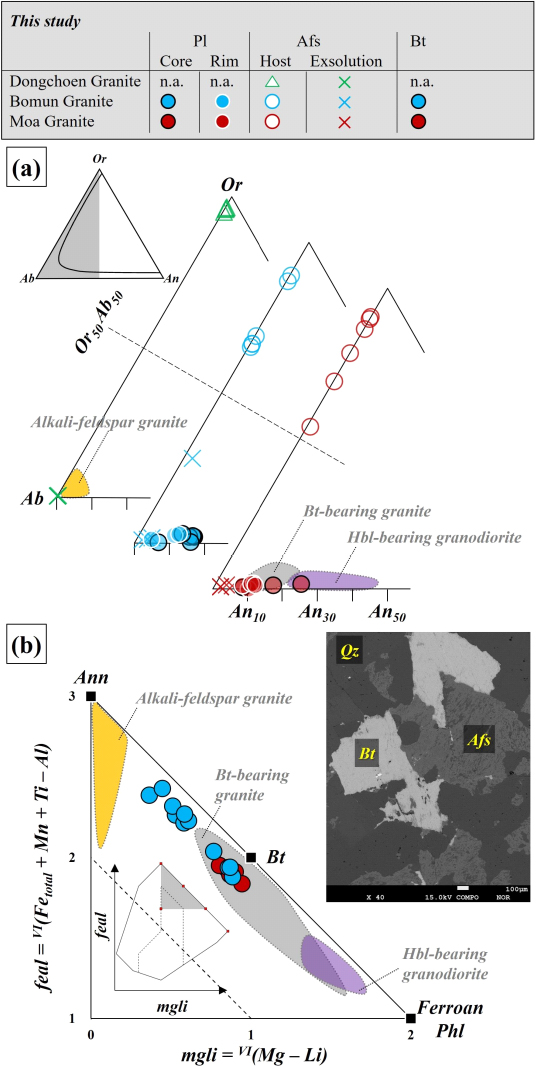
Compositional variations of (a) feldspar and (b) biotite. Biotite classification follows the scheme (O = 11) proposed by Tischendorf et al. (2004). Note that lithium abundance was assumed zero. The inset BSE image shows no compositional zoning structure. Previous plagioclase and biotite data are from Koh (2001), Lee et al. (1995) and Myeong (2017). Alkali-feldspar granite includes the Namsan and Dongcheon Granite. Bt-bearing granite represents the Gyeongju Granite. Hbl-bearing granodiorite is the Tohamsan Granite. See Figure 1a for the locations.
모아화강암에 포함된 사장석의 회장석 성분(An#)은 중심부(An8-24)가 연변부(An8-12)에 비해 높다(그림 4a). 알칼리장석의 호스트의 정장석 성분(Or#)은 Or54-90의 조성 범위를 보이며, 낮은 An0-1 함량을 가지는 반면, 용리된 장석은 높은 조장석(Ab) 성분(Ab91-97)을 가진다(그림 4a). 보문화강암에 포함된 사장석의 중심부(An7-16)는 연변부(An4-11)에 비해 높은 An#를 가진다(그림 4a). 알칼리장석의 호스트는 Or65-89의 조성을 가지며, 0.5 이하의 An#를 보인다(그림 4a). 알칼리장석 내부에서 용리된 장석은 Ab69-97의 조성을 가진다(그림 4a). 동천화강암에 포함된 알칼리장석의 호스트는 Or96-97의 조성을 가지며, An 성분을 포함하지 않는다(그림 4a). 알칼리장석 내부에서 용리된 장석은 Ab99의 조성을 가지는 거의 순수한 조장석이다(그림 4a).
이번 연구에서 분석된 흑운모는 팔면체 자리의 조성에 따라 흑운모와 앤나이트(annite) 사이에 도시되며, 조성적으로 균질한 내부조성을 가진다(그림 4b; Tischendorf et al., 2004). 모아화강암의 흑운모는 32-37의 Mg#를 가지며, 보문화강암의 흑운모는 14-35의 Mg#를 가진다. 전체적으로 Mg’는 Mg# 보다 0.1-0.6 정도 낮은 값을 가진다(표 3). 흑운모의 Mg#가 감소함에 따라, 불소(F) 함량은 2 wt.%에서 0.5 wt.%까지 감소하며, 염소(Cl) 함량은 0.18 wt.%에서 0.55 wt.%까지 증가한다(표 3).
4.3 전암화학
연구지역에서 관찰되는 화강암질 암석의 주성분원소를 지구화학적 분류도표에 도시하였다(그림 5; Frost et al., 2001). 모아화강암은 Fe* 도표에서 마그네시안(magnesian)과 페로안(ferroan) 양쪽 영역(그림 5a), MALI 도표에서는 칼크-알칼릭(calc-alkalic)과 알칼리-칼식(alkali-calcic) 영역(그림 5b) 그리고 알루미나 포화도표에서는 퍼알루미너스(peraluminous) 영역에 도시된다(그림 5c). 동일한 분류도표에서 보문화강암은 페로안 칼크-알칼릭 영역에 도시되며(그림 5a, 5b), 퍼알루미너스와 메타알루미너스(metaluminous)의 경계에 도시된다(그림 5c). 동천화강암은 페로안 칼크-알칼릭 영역에 도시되며(그림 5a, 5b), 퍼알루미너스-메타알루미너스-퍼알칼라인(peralkaline) 영역에 걸친 변화양상을 보인다(그림 5c).
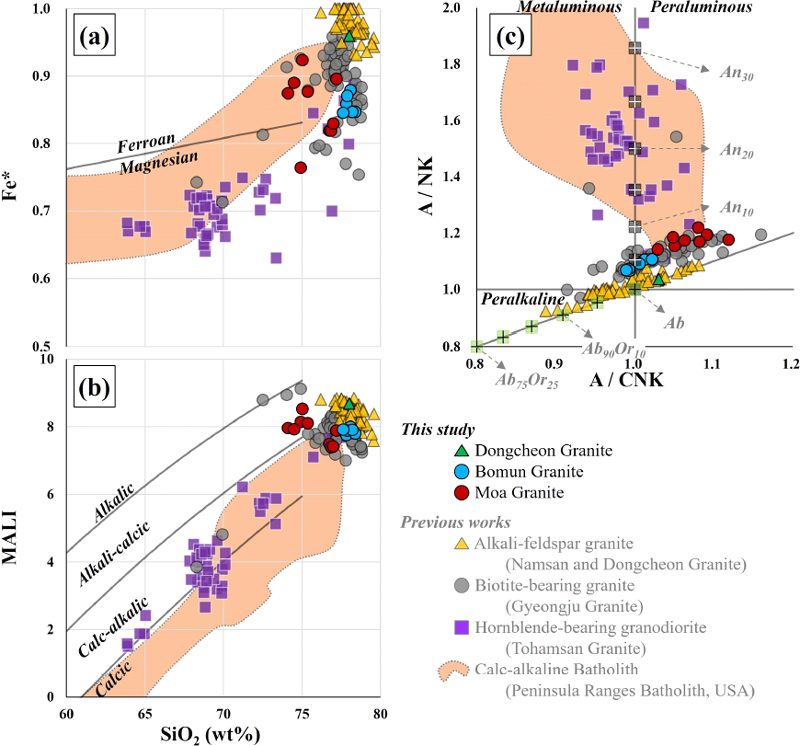
The geochemical classification of granitic rocks (Frost, B.R. et al., 2001; Frost, C.D. et al., 2016). (a) Fe* (FeOtotal / (FeOtotal + MgO)) and (b) MALI (modified alkali-lime index = Na2O + K2O - CaO) versus SiO2 diagram. (c) Alumina saturation diagram (A/NK = molar Al2O3 / (Na2O + K2O) versus A/CNK = molar Al2O3 / (CaO + Na2O + K2O). Abbreviations: An-Anorthite; Ab-Albite; Or-Orthoclase. Previous data are from: Alkali-feldspar granite (i.e., Namsan and Dongcheon Granite; Lee et al., 1995; Koh et al., 1996; Kim and Kim, 1997; Lee and Hwang, 1999; Koh, 2001; Hwang, 2004; Cheong and Jo, 2017; Myeong et al., 2017, 2018), Biotite-bearing granite (i.e., Gyeongju Granite; Lee et al., 1995; Koh et al., 1996; Kim and Kim, 1997; Lee and Hwang, 1999; Koh, 2001; Hwang, 2004; Cheong and Jo, 2017), Hornblende-bearing granodiorite (Tohamsan Granite; Lee et al., 1995; Kim and Kim, 1997; Lee and Hwang, 1999; Koh, 2001; Hwang, 2004; Cheong and Jo, 2017) and the Peninsula Ranges Batholith, USA, as a well-known arc-setting calc-alkaline granitic batholith (Lee et al., 2007).
한편, 알루미나 포화도표에서 퍼알루미너스-메타알루미너스-퍼알칼라인 영역에 걸쳐 나타나는 각 암체 별 경향은 화강암을 구성하는 광물의 집적 결과이다(Chappell et al., 2012). 이는 석영, 장석류, 운모류 그리고 각섬석이 서로 다른 A/NK 및 A/CNK 값을 가지기 때문이며(e.g., Chappell et al., 2012; 그림 5c에서 장석류에 대한 예시), 각 암체에서 자형 내지 반자형 장석류 광물이 접촉하며 집적체를 이루는 조직에 의해 지지된다(e.g., 그림 3a, 3c; Irvine, 1982; Chappell and Wyborn, 2004; Vernon and Collins, 2011).
이들 모두는 74 wt.% 이상의 높은 SiO2 함량을 가지는 고-실리카 화강암이다(그림 6; 표 4; Bachmann Bergantz, 2004; Lee and Morton, 2015; Frost et al., 2016). 전체적으로 알칼리 원소를 제외한 주성분원소의 함량은 SiO2 함량의 증가에 따라 감소하는 경향을 가진다(그림 6).
그림 7은 연구지역의 화강암질 암석의 미량원소 함량변화를 나타내며, 모아화강암과 보문화강암의 평균 모드조성과 기존에 보고된 분배계수를 통해 계산된 전체분배계수(bulk partition coefficient; Di)를 함께 보여준다(표 5). Rb 함량의 증가 및 Ba과 Sr 함량의 감소 경향은 계산된 전체분배계수와 일치한다. 희토류원소(rare earth elements; REEs)를 포함한 고장력원소(high-field strength elements; HFSEs)는 1 보다 작은 전체분배계수를 가지며, 전체적으로 분산된 경향을 보여준다. 한편, 동천화강암은 모아 및 보문화강암에 비해 강한 부화(e.g., Rb 및 HFSE) 및 강한 결핍(e.g., Ba 및 Sr)을 보여준다(그림 7).
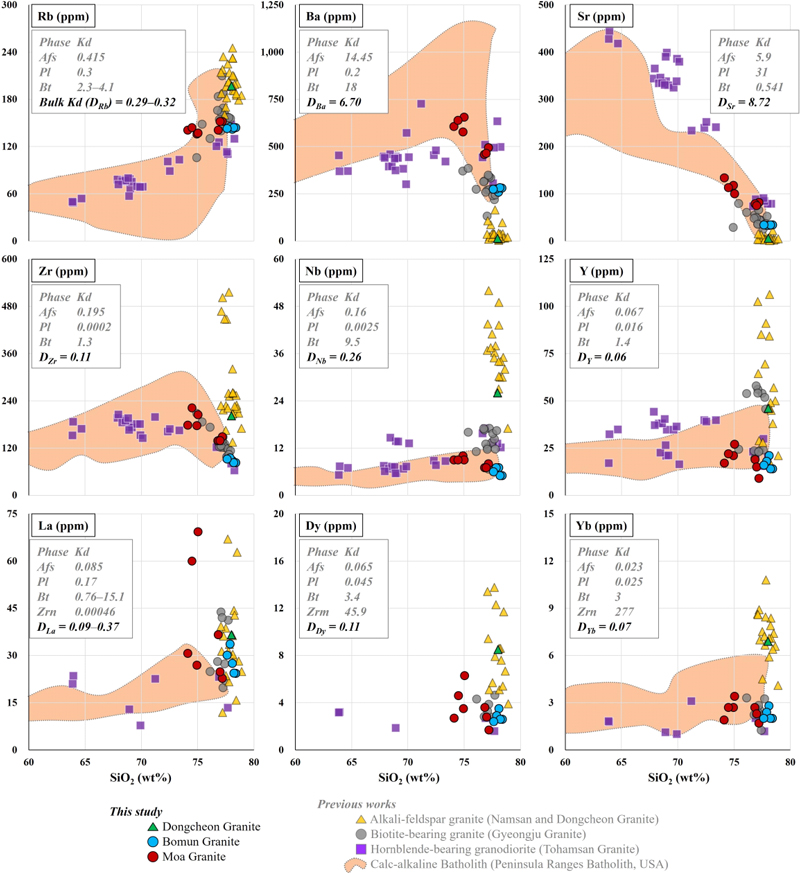
Trace elements variations of the Moa, Bomun and Dongcheon Granite. The partition coefficients (Kd) are from Stix and Gorton (1990), Ewart and Griffin (1994), Sano et al. (2002) and Rollinson and Pease (2021). Bulk partition coefficients (Di) were based on the average modal composition of the Moa and Bomun Granite (Table 1; 43.6% Afs, 34.6%Qz, 19.8% Pl and 2.0% Bt), assuming fully incompatible behavior of the trace elements for the quartz (i.e., Kd for Qz is assumed zero) (Table 5). The previous data source is provided in the Figure 5 caption.
원시맨틀(primitive mantle) 및 C1 콘드라이트(C1 Chondrite)의 조성(Sun and McDonough, 1989)으로 표준화한 화강암의 미량원소 및 희토류원소 패턴을 그림 8에 도시하였다. 모아화강암과 보문화강암의 미량원소 패턴은 상부대륙지각(Rudnick and Gao, 2014)의 형태와 유사하다(그림 8a). 하지만, 상부대륙지각에 비해 모아화강암과 보문화강암의 미량원소 조성은 Rb, Th, U 그리고 K이 부화되어 있고, Ba, Nb, Sr, P, Sm, Eu 그리고 Ti이 결핍되어 있다(그림 8a, 8b). 동천화강암은 앞의 모두에 비해 Rb, Nb, Ta 그리고 희토류원소의 함량에서는 강한 부화 특성을 보이나, Ba, Sr, P, Eu 그리고 Ti 함량은 강하게 결핍되어 있다(그림 8a, 8b).
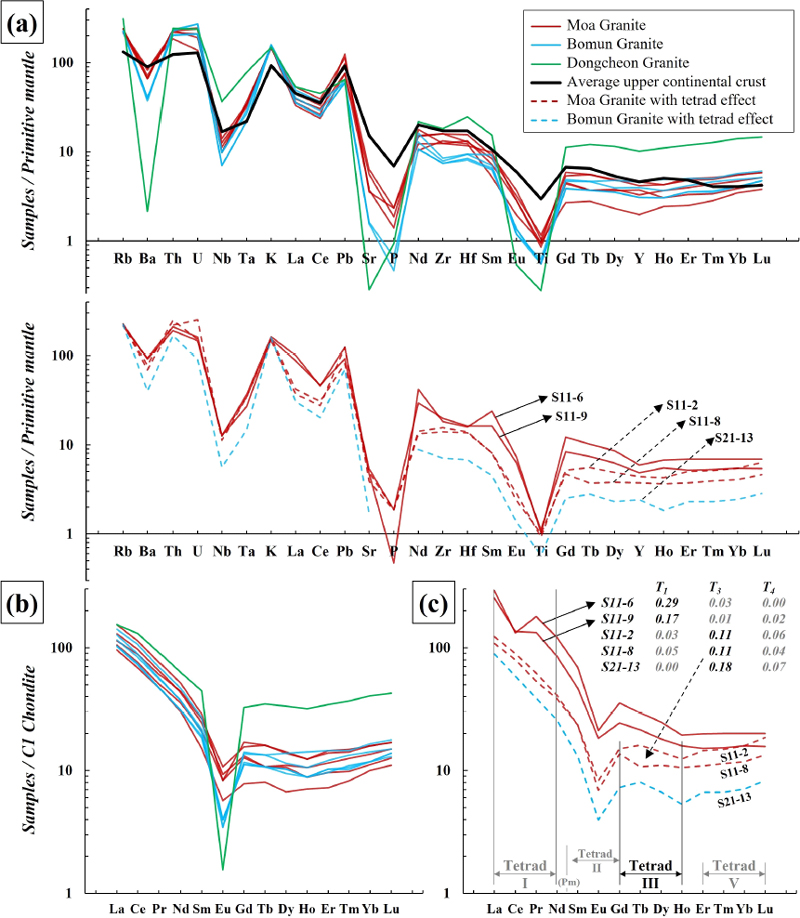
(a) Primitive mantle (Sun and McDonough, 1989) and (b) C1 Chondrite (Sun and McDonough, 1989)-normalized patterns of the Moa, Bomun and Dongcheon Granite. The trace elements compositions of the average continental crust are from Rudnick and Gao (2014). (c) The samples with tetrad effect in the third segment of rare earth elements. Ti index was calculated from the equation (2) in Monecke et al. (2002).
희토류원소 패턴은 4 개의 원소로 구성된 4개의 분절(La-Nd, Pm-Gd, Gd-Ho 그리고 Er-Lu)로 세분되며(e.g., Bau, 1996; Monecke et al., 2002), 각 분절의 중앙에 위치하는 원소들이 각 분절의 양끝에 위치하는 원소들에 비해 부화 및 결핍될 수 있다(i.e., 테트라드(tetrad) 효과; e.g., Bau, 1996; Monecke et al., 2002; Lee et al., 2013). 테트라드 효과의 존재 여부는 희토류원소에 대한 분석오차와 시료가 보이는 패턴의 기하를 통해 정량적으로 확인될 수 있다(i.e., Ti index (i = 1-4); See equations in Monecke et al., 2002). 이때 첫번째와 두번째 분절이 각각 산소 분압에 따라 다른 양전하를 가질 수 있는 Ce4+과 Eu2+을 포함하기 때문에(e.g., Rollinson and Pease, 2021), 세번째와 네번째 분절의 특성이 첫번째와 두번째 분절보다 유용하게 사용될 수 있다.
이번 연구의 희토류원소 분석치는 10% 이하의 오차를 가지며(표 4), 이는 0.1 이상의 Ti 값을 보이는 시료는 유의미한 테트라드 효과를 가진다는 점을 뜻한다(Monecke et al., 2002). 이번 연구의 시료들 중 모아화강암(i.e., S11-2 and -8) 과 보문화강암(i.e., S21-13)의 일부 시료들은 희토류원소의 세번째 분절에서 테트라드 효과를 보인다(그림 8c). 모아화강암의 S11-6 및 -9 시료는 첫번째 분절에서 0.1 보다 높은 T1 지표를 보이지만, 세번째 분절에서 테트라드 효과를 보이지 않는다. 따라서, S11-6 및 -9 시료는 테트라드 효과를 가지지 않는 것으로 간주하였다. 테트라드 효과를 가지는 시료의 지구화학적 조성은 일반적인 용융체-광물 평형조건에서 얻어진 분배계수를 통해 설명되기 어렵다(e.g., Bau, 1996). 따라서, 이어지는 토의에서 기존의 전암화학 데이터에 대한 평가를 수행하였다.
5. 토 의
5.1 인근 화강암체에 대한 기존 데이터 종합
천부지각에 저류된 화강암질 마그마는 주변 온도와 용융체의 조성에 따라 수 kyr-Myr에 걸쳐 고상선 이상의 온도에서 결정죽 상태를 유지할 수 있다(e.g., Bachmann and Huber, 2016; Schaen et al., 2017; Chen et al., 2023). 그림 9는 연구지역 일대의 화강암질 암석에 대해 종합된 SHRIMP U-Pb 저어콘 겉보기 206Pb-238U 연령 범위를 보여준다. 이는 58-50 Ma에 걸쳐 지속적으로 저어콘이 결정화되었음을 지시하며, 곧 일대의 화강암질 결정죽이 대략 8 Myr 동안 유지되었음을 시사한다.
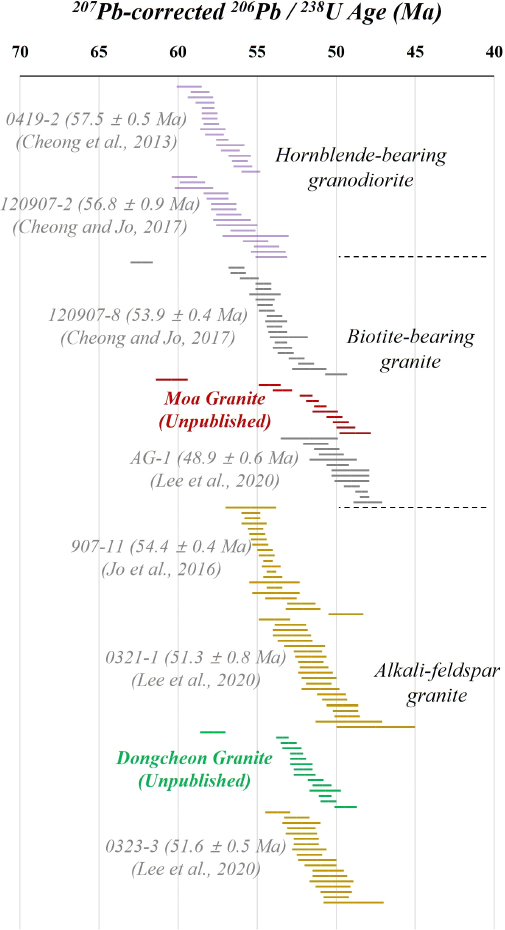
SHRIMP (Sensitive High Resolution Ion MicroProbe) U-Pb zircon age compilation. Previous data are from: Hornblende-bearing granodiorite (i.e., Tohamsan Granite; Cheong et al., 2013; Cheong and Jo, 2017), Biotite-bearing granite (i.e., Gyeongju Granite; Cheong and Jo, 2017; Lee et al., 2020, Unpublished data) and Alkali-feldspar granite (i.e., Namsan and Dongcheon Granite; Jo et al., 2016; Lee et al., 2020, Unpublished data).
일대에 분포하는 화강암질 암석과 성인적 관련성을 확인하기 위해서 각섬석 화강섬록암(토함산화강암), 흑운모 화강암(경주화강암) 그리고 알칼리장석 화강암(남산화강암)에 대한 기존의 전암조성이 종합되었다(그림 1a, 10). 비교를 위한 기존 데이터 선별기준은 다음과 같다: (1) 주성분원소 산화물의 합이 97-102 wt.% 범위 내에 있는 것; 이 기준을 통해 배제된 시료는 없었다. (2) 동일한 암체에 대해 HFSEs의 함량이 과소 또는 과대평가되지 않은 것; 예를 들어, Lee and Hwang (1999)의 데이터는 동일한 SiO2 함량에서 Zr과 Hf 함량은 과소평가된 반면, Ta의 함량은 과대평가되어 있다(그림 10a). Koh (2001)의 데이터는 동일한 SiO2 함량에 대해 Ta 함량이 과대평가되어 있다(그림 10a). 이러한 차이점은 시료 전처리 과정동안 저어콘과 같은 내열성광물(refractory mineral)의 불완전용해(e.g., Park et al., 2013) 또는 분석 보정의 오류에 기인한 것으로 생각되나, 정확한 원인은 불확실하다. 그리고 (3) 테트라드 효과를 보이지 않는 것; 10%의 분석오차를 가정하고, 희토류원소의 세번째 그리고 네번째 분절에서 테트라드 효과를 보이는 시료(i.e., T3 그리고/또는 T4가 0.1 이상의 값을 보이는 것; Monecke et al., 2002)들이 제외되었다(그림 10b). (2)와 (3)의 경우에 해당되는 시료는 시료의 주성분원소 조성만이 사용되었다. 이러한 데이터 선별기준은 이번 연구에서 보고한 전암조성에도 동일하게 적용되었다.
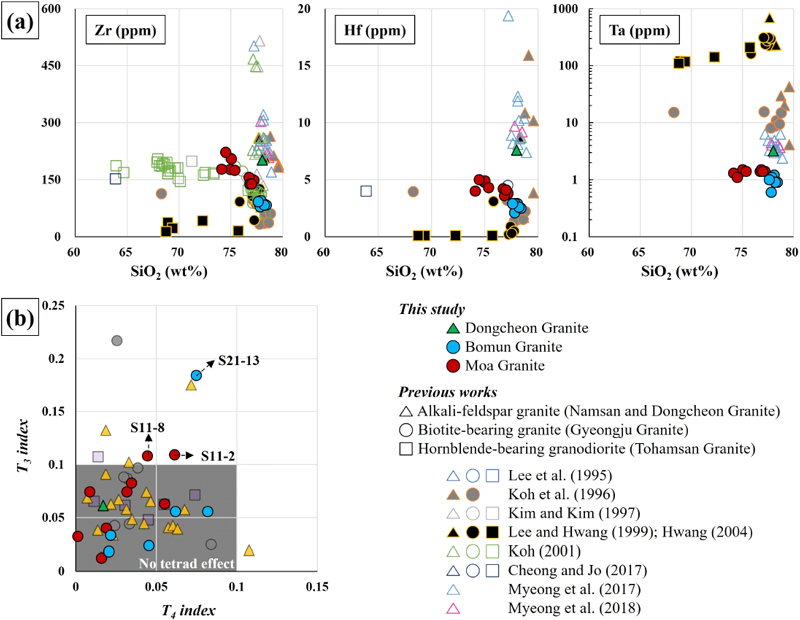
(a) HFSEs versus SiO2 diagram. Note that the tantalum diagram has log-scale vertical axis. (b) T3 versus T4 index (based on the equation (2) in Monecke et al., 2002) diagram for testing the REEs tetrad effect.
비교대상들에 대해 선별된 데이터의 개수 그리고 각 원소의 최소값 및 최대값이 표 6 및 그림 11에 요약되어 있고, 그 결과가 그림 5-7에 반영되어 있다. 일부 미량원소들(i.e., U, Ta, Hf 그리고 Dy)에 대해 사용가능한 데이터의 개수가 5개 이하로 적기 때문에(표 6), 이러한 원소들의 지구화학적 거동에 근거한 암석성인추론은 제한적이다(그림 11). 각 암체의 평균 조성에 근사한 대표시료가 비교를 위해 함께 도시되었다(그림 11). 전체적으로 모아화강암과 보문화강암의 미량원소 패턴은 흑운모 화강암의 범위 안에 도시되며, 동천화강암의 미량원소 패턴은 알칼리장석 화강암의 범위에 도시된다. 비교대상들에서 나타나는 강한 음 또는 양의 이상(anomaly)를 제외하면, 희토류원소는 비슷한 기울기를 가진 채 각섬석 화강섬록암, 흑운모 화강암 그리고 알칼리장석 화강암 순으로 점점 부화되는 함량을 보인다.

The results of data filtering for alkali-feldspar granite, biotite-bearing granite and hornblende-bearing granodiorite in the study area.
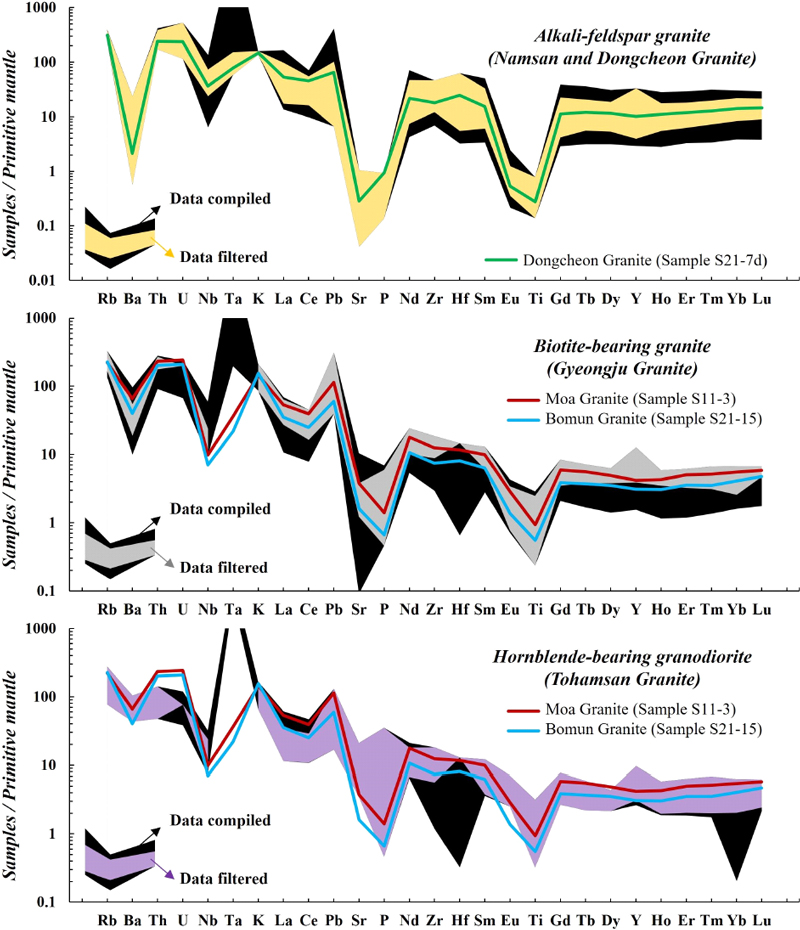
The result of data filtering for alkali-feldspar granite, biotite-bearing granite and hornblende-bearing granodiorite. The previous data source is provided in the Figure 5 caption and the filtering results are summarized in Table 6. Samples S11-3, S21-15 and S21-7d are shown for comparison. Note that the previous data set presented in the Figures 5-7 are the survived ones from the data filtering criteria of this study.
요약하자면, 연구지역 일대 화강암질 암석의 중첩되는 저어콘 결정화 연령범위(그림 9) 그리고 연속적인 전암화학조성(그림 6, 7, 11)은 이들이 모두 동일한 기원을 가지는 마그마에서 일어난 분별정출의 산물일 가능성을 시사한다. 따라서, 이후의 단락은 각 암질의 관계를 토의한다.
5.2 지구화학적 특징을 통한 진화모델 수립
마그네시안 메타알루미너스 칼크-알칼릭 그룹은 화산호 환경에서 Al 함량이 높은 현무암 내지 안산암의 분화를 통해 산출된다(Frost et al., 2016). 모아화강암(i.e., An8-24)과 보문화강암(i.e., An7-16)에 포함된 사장석 중심부는 대체로 10 이상의 An#를 가지며(그림 4a), 이는 현재 이들의 전암조성에서 만들어질 수 있는 약 5 내외의 사장석의 An# 보다 높은 값이다(그림 5c). 이러한 특징은 경주화강암의 기존 데이터에서도 나타난다(그림 4a, 5c; Koh, 2001). 따라서, 흑운모 화강암에 포함된 사장석의 중심부는 보다 덜 분화된 조성의 마그마에서 기원한 재활결정(antecryst)으로 해석될 수 있다(e.g., 그림 3a). 한편, 주변에 분포하는 각섬석 화강섬록암(토함산화강암; 그림 1a)의 전암조성은 An10-30 해당되는 사장석을 형성할 수 있는 것으로 판단되며(그림 5c), 이는 토함산화강암의 사장석 조성범위(An22-43Ab55-74Or2-3; Koh, 2001)에 해당한다(그림 4a). 사장석의 조성변화 양상은 일대의 흑운모 화강암이 각섬석 화강섬록암을 형성하고 남은 마그마에서 기원 되었을 가능성을 시사한다(그림 4a). 이는 각섬석 화강섬록암과 흑운모 화강암을 별개의 관입체(Lee et al., 1995; Kim and Kim, 1997)보다는 마그마의 점진적인 분화산물(Koh et al., 1996; Lee and Hwang, 1999)로 본 기존의 일부 견해와 부합한다.
마그네시안 메타알루미너스 칼크-알칼릭 그룹이 높은 정도의 분화를 경험할 경우 페로안 퍼알루미너스 칼크-알칼릭 특성을 보일 수 있다(Frost et al., 2016; 그림 5-7). 미국 서부 Peninsular Ranges Batholith는 화산호 환경에서 형성된 화강암질 저반의 진화 사례를 보여주며(Lee et al., 2007), 이러한 지구화학적 진화경로는 이번 연구에서 다루는 화강암질 암석이 보여주는 것과 상당히 유사하다(그림 5-7). 따라서, 알칼리장석 화강암의 전암조성 변화양상은 이들이 일대에 분포하는 흑운모 화강암의 분화산물일 수 있다는 점을 시사한다(Lee and Hwang, 1999). 하지만, Peninsular Ranges Batholith의 경우에 비해, 연구지역 일대의 알칼리장석 화강암은 높은 SiO2 함량(76-80 wt.%)을 가지며 다양한 정도로 HFSEs가 부화 및 결핍되어 있기 때문에(그림 7), 이러한 지구화학적 특징에 대한 추가적인 설명이 필요하다.
화강암의 HFSEs 함량은 주로 저어콘과 같은 미량광물의 모드조성에 따라 조절되며, 이는 저어콘의 KdHFSEs가 화강암을 구성하는 다른 상들에 비해 월등히 높기 때문이다(e.g., 그림 7; Sano et al., 2002). 동천화강암 내부에 포함된 저어콘은 용해된 양상을 보인다(e.g., 그림 3h). 게다가, 남산화강암에서 분리된 저어콘은 넓은 라만 분광(Raman spectroscopy) 피크폭을 보이며(Jo et al., 2016), 이 역시 저어콘의 용해를 통해 낮아진 결정도 때문으로 판단된다.
Keppler (1993)의 실험에 의하면, 200 MPa 그리고 800℃ 조건에 있는 화강암질 용융체에 대한 저어콘의 용해도(solubility)는 용융체에 포함된 F의 함량과 지수적 양의 상관관계를 가진다. 한편, 200 MPa 그리고 640-680℃ 조건에 있는 화강암질 용융체에서 흑운모에 대한 F의 Kd는 흑운모의 Mg’와 선형적 양의 상관관계를 가진다(Icenhower and London, 1997). Keppler (1993)과 Icenhower and London (1997)의 실험암석학적 조건은 화강암질 마그마의 지각천부 정치조건을 의미하며, 이는 불국사화강암의 지각천부 정치 조건과 유사하다(e.g., Cho and Kwon, 1994; Koh et al., 2000). 따라서, Icenhower and London (1997)의 상관식을 따라 KdFBt-Melt를 가정하면, 연구지역 일대의 화강암 내부의 간극에 존재했던 F 함량을 추정할 수 있다. 연구지역 일대의 화강암질 암석에 포함된 흑운모는 대략 2.5 wt.% 미만의 F를 가지는 한편(그림 12a), 이로부터 추정된 간극상 용융체의 F 함량은 암체 별로 큰 차이를 보인다(그림 12b): 토함산화강암(0.02-0.04 wt.%), 경주화강암(0.2-0.7 wt.%), 남산화강암(3.2-14.2 wt.%), 모아화강암(0.4-0.5 wt.%) 그리고 보문화강암(0.3-0.6 wt.%). Keppler (1993)이 제안한 식을 적용하면, 10 wt.%의 F이 포함된 용융체는 대략 0.7 wt.% ZrO2를 용해시킬 수 있으며, 이는 알칼리장석 화강암의 전암조성이 보이는 수백 ppm의 Zr 함량보다 월등히 높은 값이다(그림 7).

(a) F (wt.%) abundance with respect to the decreasing biotite Mg# (See also, Table 3). (b) Modeled interstitial F (wt.%) abundance using KdFBt-Melt of Icenhower and London (1997). Biotite compositions are from alkali-feldspar granite (Lee et al., 1995; Myeong, 2017), biotite-bearing granite (Lee et al., 1995; Myeong, 2017) and hornblende-bearing granodiorite (Lee et al., 1995). Note that biotite crystals in the Dongcheon Granite have low oxides totals less than 90 wt.% with low K abundance, which may indicate alteration into chlorite ± Fe-hydroxides; thus, they were not used in this study.
저어콘 용해도는 용융체의 알칼리 원소 함량과 양의 상관관계를 가지며, 이는 알칼리 원소가 저어콘 결정을 형성하는 지르코늄과 산소의 결합을 어렵게 하기 때문이다 (e.g., Watson and Herrison, 1983; Boehnke et al., 2013; Gervasoni et al., 2016). 알칼리장석 화강암은 흑운모 화강암에 비해 높은 알칼리 원소 함량을 가지며(그림 6), 퍼알칼라인 특성을 보인다(그림 5c). 따라서, 알칼리장석 화강암이 보이는 높은 F (그림 12b)과 알칼리 원소(그림 5c) 함량은 간극상 용융체 내지 유체(fluid)에서 성장하던 저어콘을 용해시켰을 수 있다(Watson and Herrison, 1983; Icenhower and London, 1997). 이러한 과정에서 저어콘이 경험할 수 있는 다양한 정도의 용해 그리고 간극상 공간을 따라 분포하는 불규칙적인 반응 유체의 분포는 알칼리장석 화강암으로 하여금 넓은 범위에 걸쳐 분산된 HFSEs 변화양상을 가지게 했던 것으로 추정된다. 하지만, 향후 각 암체에서 나타나는 저어콘의 미세조직, 미량원소 및 안정동위원소 특성을 통해 저어콘과 반응한 유체의 기원 그리고 그 반응과정이 파악될 필요가 있다.
5.3 고-실리카 화강암의 형성
연구지역 일대의 흑운모 화강암과 알칼리장석 화강암은 대부분 75 wt.% 이상의 높은 SiO2 함량을 보인다(그림 5-7). 이는 다른 화산호 지역의 화강암질 암석보다 대략 5 wt.% 정도 높은 값이며(c.f., Lee and Morton, 2015; Frost et al., 2016), 연구지역 일대의 천부지각에서 보다 극적인 마그마 분화작용이 일어났음을 시사한다.
모아화강암과 보문화강암의 평균 모드조성 그리고 이들을 구성하는 상들에 대해 보고된 분배계수를 이용하여(표 5), 분별정출 모델을 통해 고-실리카 화강암의 조성적 진화과정을 추론하였다(그림 13). 모아화강암과 보문화강암의 평균조성에 가까운 S11-3 시료를 규장질 모마그마로 가정하였다. 연구지역 일대의 화강암질 암석은 SiO2 함량이 증가함에 따라 지속적으로 증가하는 Rb 및 지속적으로 감소하는 Sr 함량 변화를 보여준다(그림 7). 따라서, Rb/Sr 비(ratio)는 이번 연구의 경우처럼 좁은 SiO2 함량 변화 범위(74-78 wt.%; 그림 6, 7)에서 일어나는 마그마 분화를 민감하게 반영할 수 있다.
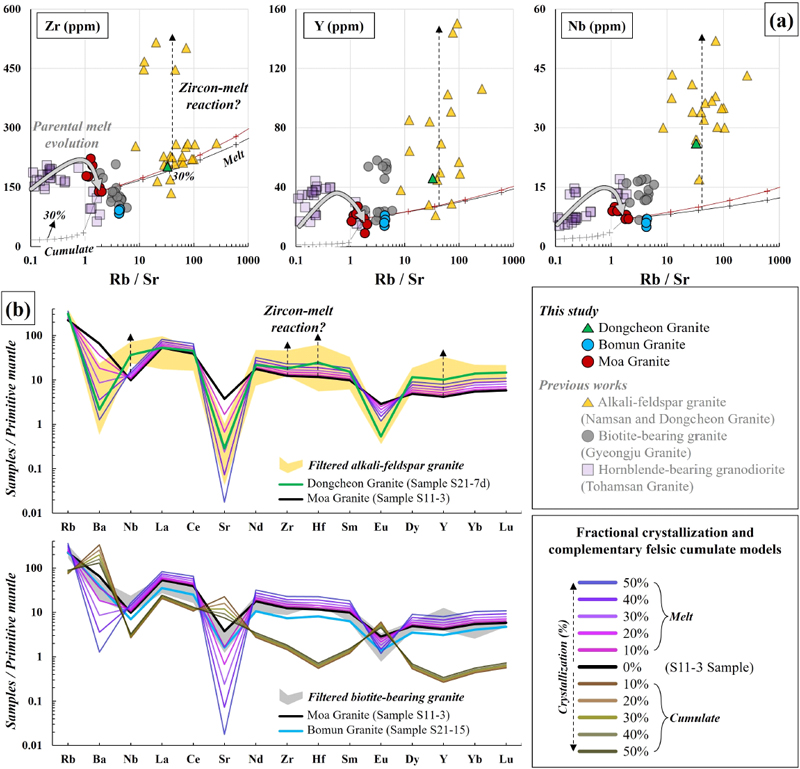
(a) Zr, Y and Nb versus Rb/Sr diagram. The thick white arrow represents an intermediate melt evolution to form felsic parental magma with a more evolved composition (i.e., sample S11-3 from the Moa Granite). The black and gray curves with crosses (10% interval), respectively, indicate the modeled melt and cumulate compositions. The red curve assumes completely incompatible behaviors (i.e., DZr, Y, Nb = 0). The black broken arrow is a possible result of zircon dissolution, liberating some HFSEs compatible with zircon. (b) Modeled compositions of the melt and complementary felsic cumulate. Note that the model parameters are summarized in Table 5 and the previous data source is provided in the Figure 5 caption.
알칼리장석 화강암은 규장질 모마그마로부터 진화한 용융체의 조성곡선을 따라 도시되며(그림 13a), 이러한 경향은 다른 미량원소들에서도 확인된다(그림 13b). 저어콘에 호정적인 원소(e.g., Zr, Y, Nb 그리고 Hf)는 용융체의 분화곡선 위아래로 분산되는 경향을 보인다(그림 13). 이러한 원소들이 분별정출 과정동안 완전히 비호정적인 거동(i.e., DZr, Y, Nb = 0)을 한다고 가정해도, 알칼리장석 화강암의 강한 부화양상은 설명되지 않는다(그림 13a). 하지만, 앞에서 토의된 것처럼 저어콘의 용해(e.g., 그림 3h)가 이러한 원소들의 분산에 관련된 것으로 판단된다. 알칼리장석 화강암의 La, Ce 그리고 Eu 함량은 계산된 용융체 조성에 비해 결핍되어 있는데(그림 13b), 이는 규장질 누적암의 일부가 알칼리장석 화강암으로 유입되었기 때문으로 생각된다. 한편, 일부 각섬석 화강섬록암과 흑운모 화강암의 전암조성은 진화하는 용융체와 그로부터 결정화되는 누적암의 혼합을 통해 설명될 수 있다. 예를 들어, 30% 결정화에 상응하는 용융체와 규장질 누적암의 혼합은 보문화강암을 비롯한 일대 흑운모 화강암의 미량원소 조성을 설명할 수 있다(그림 13a).
결정과 용융체의 물리적 분리과정은 (1) 중력에 의한 마그마 저장고 내부 결정의 침강(gravitational settling), (2) 누적된 결정의 무게에 의한 결정죽의 압밀작용(compaction), 또는 (3) 조구조 환경에 기인한 외부응력을 통한 결정죽의 변형으로 설명될 수 있다(e.g., Bowen, 1920; Holness, 2018; Petford et al., 2020). 양산단층의 재활성 시기들 중 일부(i.e., ~64-50 Ma; Cheon et al., 2019)가 연구지역의 고-실리카 화강암이 보이는 U-Pb 저어콘 연령범위(i.e., ~58-50 Ma; 그림 9)를 포함한다는 점은 양산단층에 작용한 일대의 응력이 결정죽의 변형에 영향을 끼쳤을 가능성을 시사한다(e.g., Troll et al., 2020). 하지만, 앞의 두가지 가설도 완전히 배제될 수는 없으며, 이는 연구지역 일대의 고-실리카 화강암에 대한 자세한 야외산상(e.g., Schaen et al., 2018) 및 미세조직(e.g., Holness, 2018)에 대한 심층적 연구를 통해 확인이 필요하다.
결론적으로 연구지역 일대의 고-실리카 화강암은 모마그마에서 결정화된 규장질 누적암과 결정죽에서 추출되어 분리된 용융체의 상대적인 기여에 따라, 누적암이 우세한 영역은 흑운모 화강암으로, 용융체가 우세한 부분은 알칼리장석 화강암으로 산출되는 것으로 판단된다(그림 13). 이번 연구의 해석이 맞다면, 일대의 알칼리장석 화강암이 판내부 환경에서 형성되었다는 기존의 해석은 재고될 필요가 있다(e.g., Pearce et al., 1984). 이는 소위 A(anorogenic)-형 화강암으로 알려진 남산 및 동천화강암의 조성이 결정죽에서 빠져나온 용융체 그리고 저어콘의 용해를 통해 설명될 수 있기 때문이다(그림 14; e.g., Chen et al., 2023). 따라서, 이번 연구는 경주 일대에 분포하는 각섬석 화강섬록암-흑운모 화강암-알칼리장석 화강암을 화산호 지각 천부에서 진화한 하나의 연속적인 관입체로 해석한다(e.g., Bachmann and Bergantz, 2004; Lee and Morton, 2015; Schaen et al., 2018; Chen et al., 2023). 이번 연구의 추론은 이들이 서로 다른 조구조적 환경(i.e., 화산호 versus 판내부), 서로 다른 기원물질(i.e., 맨틀물질의 관여여부) 그리고 서로 다른 관입시기(i.e., 대략 55 Ma 전후)를 가진다는 기존의 해석에 대안적이며, 경주 일대 불국사화강암에 대한 보다 심층적인 연구가 필요함을 시사한다.
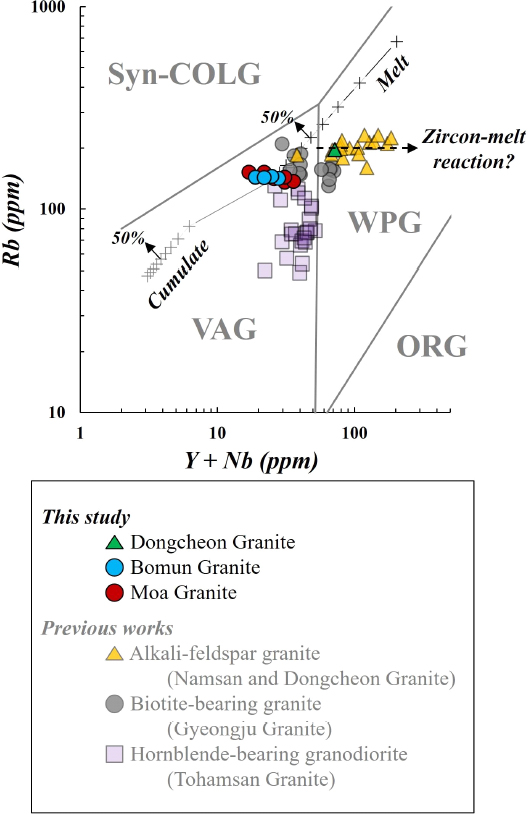
Tectonic discrimination diagram for granitic rocks (Pearce et al., 1984) in the study area. The black and gray curves with crosses (10% interval), respectively, indicate the modeled melt and cumulate compositions. The black broken arrow is a possible result of zircon dissolution. The previous data source is provided in the Figure 5 caption. Abbreviations: ORG-Ocean Ridge Granites; VAG-Volcanic Arc Granites; WPG-Within Plate Granites; Syn-COLG-Syn-collision Granites.
6. 결론 및 제언
이번 연구는 경주 일대 양산단층 동부에서 산출되는 흑운모 화강암(모아 및 보문화강암)과 알칼리장석 화강암(동천화강암)의 암석학적 특징을 보고하였다. 이들은 모두 5 modal% 미만의 고철질 광물(i.e., 불투명광물, 형석, 스핀, 갈렴석, 각섬석, 인회석, 모나자이트 그리고 저어콘; Le Maitre et al., 2002)을 포함하기 때문에 우백질 화강암이며, 모드조성상 몬조화강암-섬장화강암-알칼리장석 화강암으로 분류된다. 우백질 화강암에 포함된 사장석은 30 이하의 An#를 가지는 한편, 알칼리장석은 50 이상의 Or#를 보인다. 이들이 포함하는 흑운모는 40 이하의 Mg#를 가진다. 전체적으로 흑운모 화강암-알칼리장석 화강암 순으로 점차 분화된 조성을 가진다.
전암 주성분원소의 관점에서 이번 연구의 우백질 화강암은 74-78 wt.% SiO2 함량범위를 가지기 때문에 고-실리카 화강암으로 여겨질 수 있다. 흑운모 화강암은 마그네시안 메타알루미너스 칼크-알칼릭 특성을 가지며, 알칼리장석 화강암은 페로안 퍼알루미너스 칼크-알칼릭 특성을 보인다. 미량원소 조성을 사용한 분별정출 모델을 바탕으로 흑운모 화강암은 규장질 누적암이 우세한 결정죽으로 해석되었으며, 알칼리장석 화강암은 그러한 결정죽에서 추출된 용융체로 해석되었다. 이들의 지구화학적 특성은 흑운모 화강암과 알칼리장석 화강암이 화산호의 천부지각에서 형성된 결정죽에서 기원했으며, 연속적인 진화경로를 가진다는 점을 지시한다. 이러한 해석은 조구조적 환경, 기원물질 그리고 관입시기에 따라 경주 일대의 흑운모 화강암과 알칼리장석 화강암의 성인을 다르게 본 기존의 해석이 재고될 필요가 있음을 시사한다.
Acknowledgments
이 논문은 2016년도 정부(교육부)의 재원으로 한국연구재단의 지원을 받아 수행된 기초연구사업(No. 2016R1A6A1A05011910)입니다. 그림 9에 사용된 미발표 저어콘 연령 데이터는 한국기초과학지원연구원 오창센터에서 실시한 2017년 연대측정스쿨 프로그램에서 얻어졌습니다. 논문의 심사과정에 건설적인 조언과 귀중한 시간을 기꺼이 내어 주신 두 분의 심사위원님들과 편집위원님께 깊이 감사드립니다.
References
-
Bachmann, O. and Bergantz, G.W., 2004, On the origin of crystal-poor rhyolites: extracted from batholithic crystal mushes. Journal of Petrology, 45, 1565-1582.
[https://doi.org/10.1093/petrology/egh019]

-
Bachmann, O. and Huber, C., 2016, Silicic magma reservoirs in the Earth’s crust. American Mineralogist, 101, 2377-2404.
[https://doi.org/10.2138/am-2016-5675]

-
Barbee, O., Chesner, C. and Deering, C., 2020, Quartz crystals in Toba rhyolites show textures symptomatic of rapid crystallization. American Mineralogist, 105, 194-226.
[https://doi.org/10.2138/am-2020-6947]

-
Barnes, C.G., Werts, K., Memeti, V. and Ardill, K., 2019, Most granitoid rocks are cumulates: deductions from hornblende compositions and zircon saturation. Journal of Petrology, 60, 2227-2240.
[https://doi.org/10.1093/petrology/egaa008]

-
Bau, M., 1996, Controls on the fractionation of isovalent trace elements in magmatic and aqueous systems: evidence from Y/Ho, Zr/Hf, and lanthanide tetrad effect. Contributions to Mineralogy and Petrology, 123, 323-333.
[https://doi.org/10.1007/s004100050159]

-
Boehnke, P., Watson, E.B., Trail, D., Harrison, T.M. and Schmitt, A.K., 2013, Zircon saturation re-revisited. Chemical Geology, 351, 324-334.
[https://doi.org/10.1016/j.chemgeo.2013.05.028]

-
Bowen, N.L., 1920, Differentiation by deformation. Proceedings of the National Academy of Sciences 6, 159-162.
[https://doi.org/10.1073/pnas.6.4.159]

-
Cashman, K.V., Sparks, R.S.J. and Blundy, J.D., 2017, Vertically extensive and unstable magmatic systems: a unified view of igneous processes. Science, 355, eaag 3055.
[https://doi.org/10.1126/science.aag3055]

-
Chae, Y., Choi, T., Paik, I.S., Kim, J.-S., Kim, H.J., Jeong, H.Y. and Lim, H.S., 2021, Detrital zircon U-Pb ages of the Cretaceous Global Geopark, Korea: Depositional age and Provenance. Journal of the Korean Earth Science Society, 42, 11-38 (in Korean with English abstract).
[https://doi.org/10.5467/JKESS.2021.42.1.11]

- Chang, K.H., 1975, Cretaceous stratigraphy of southeast Korea. Journal of the Geological Society of Korea, 11, 1-23.
-
Chappell, B.W., Bryant, C.J. and Wyborn, D., 2012, Peraluminous I-type granites. Lithos, 153, 142-153.
[https://doi.org/10.1016/j.lithos.2012.07.008]

-
Chappell, B.W. and Wyborn, D., 2004, Cumulate and cumulative granites and associated rocks. Resource Geology, 54, 227-240.
[https://doi.org/10.1111/j.1751-3928.2004.tb00204.x]

-
Chen, J.Y., Yang, J.H., Zhang, J.H., Zhu, Y.S. and Yang, Z.G., 2023, Zircon reveals crystal-melt segregation processes in the genesis of Cretaceous A-type granites and related cumulated rocks in southeastern China. Chemical Geology, 619, 121303.
[https://doi.org/10.1016/j.chemgeo.2023.121303]

-
Cheon, Y., Cho, H., Ha, S., Kang, H.-C., Kim, J.-S. and Son, M., 2019, Tectonically controlled multiple stages of deformation along the Yangsan Fault Zone, SE Korea, since Late Cretaceous. Journal of Asian Earth Sciences, 170, 188-207.
[https://doi.org/10.1016/j.jseaes.2018.11.003]

-
Cheong, A.C.-S. and Jo, H.J., 2017, Crustal evolution in the Gyeongsang Arc, southeastern Korea: Geochronological, geochemical and Sr-Nd-Hf isotopic constraints from granitoid rocks. American Journal of Science, 317, 369-410.
[https://doi.org/10.2475/03.2017.03]

-
Cheong, A.C.-S., Jung, M.J., Jo, H.J., Kim, J., Lee, S. and Jeong, Y.J., 2023, Lithospheric thinning and ignition of a Cordilleran magmatic flare-up: Geochemical and O-Hf isotopic constraints from Cretaceous plutons in southern Korea. Geoscience Frontiers, 14, 101492.
[https://doi.org/10.1016/j.gsf.2022.101492]

-
Cheong, C.S., Yi, K., Kim, N., Lee, T.H., Lee, S.R., Geng, J.Z. and Li, H.K., 2013, Tracking source materials of Phanerozoic granitoids in South Korea by zircon Hf isotopes. Terra Nova, 25, 228-235.
[https://doi.org/10.1111/ter.12027]

- Cho, D.-L. and Kwon, S.-T., 1994, Hornblende geobarometry of the Mesozoic granitoids in South Korea and the evolution of crustal thickness. Journal of the Geological Society of Korea, 30, 41-61 (in Korean with English abstract).
- Choi, M.-S., Cheong, A.C.-S. and Park, K.-H., 1994, An experimental study on the trace element analysis of rock samples with regard to the decomposition method. Korean Journal of Mineralogy and Petrology, 3, 41-48 (in Korean with English abstract).
-
Choi, T. and Kwon, M.G., 2019, Depositional age and provenance of the sandstones in the Cretaceous Euiseong subbasin inferred by detrital zircon U-Pb age dating. Journal of the Geological Society of Korea, 55, 551-581 (in Korean with English abstract).
[https://doi.org/10.14770/jgsk.2019.55.5.551]

-
Chough, S.K. and Sohn, Y.K., 2010, Tectonic and sedimentary evolution of a Cretaceous continental arc-backarc system in the Korean peninsula: new view. Earth-Science Reviews, 101, 225-249.
[https://doi.org/10.1016/j.earscirev.2010.05.004]

-
Deering, C.D. and Bachmann, O., 2010, Trace element indicators of crystal accumulation in silicic igneous rocks. Earth and Planetary Science Letters, 297, 324-331.
[https://doi.org/10.1016/j.epsl.2010.06.034]

-
Ewart, A. and Griffin, W.L., 1994, Application of protonmicroprobe data to trace-element partitioning in volcanic rocks. Chemical Geology, 117, 251-284.
[https://doi.org/10.1016/0009-2541(94)90131-7]

-
Frost, B.R., Barnes, C.G., Collins, W.J., Arculus, R.J., Ellis, D.J. and Frost, C.D., 2001, A geochemical classification for granitic rocks. Journal of Petrology, 42, 2033-2048.
[https://doi.org/10.1093/petrology/42.11.2033]

-
Frost, C.D., Frost, B.R. and Beard, J.S., 2016, On silica-rich granitoids and their eruptive equivalents. American Mineralogist, 101, 1268-1284.
[https://doi.org/10.2138/am-2016-5307]

-
Gervasoni, F., Klemme, S., Rocha-Júnior, E.R. and Berndt, J., 2016, Zircon saturation in silicate melts: a new and improved model for aluminous and alkaline melts. Contributions to Mineralogy and Petrology, 171, 1-12.
[https://doi.org/10.1007/s00410-016-1227-y]

-
Holness, M.B., 2018, Melt segregation from silicic crystal mushes: a critical appraisal of possible mechanisms and their microstructural record. Contributions to Mineralogy and Petrology, 173, 48.
[https://doi.org/10.1007/s00410-018-1465-2]

- Hwang, B.-H., 2004, Petrology, isotope and petrogenesis of the granitic rocks in the southern Gyeongsang Basin. Ph.D. thesis, Pusan National University, Pusan, 309 p (in Korean with English abstract).
-
Hwang, B.-H., Ernst, W.G. and Yang, K., 2012, Two different magma series imply a Palaeogene tectonic transition from contraction to extension in the SE Korean Peninsula. International Geology Review, 54, 1284-1295.
[https://doi.org/10.1080/00206814.2011.636990]

-
Hwang, B.-H., McWilliams, M., Son, M. and Yang, K., 2007, Tectonic implication of A-type granites across the Yangsan fault, Gigye and Gyeongju areas, southeast Korean Peninsula. International Geology Review, 49, 1094-1102.
[https://doi.org/10.2747/0020-6814.49.12.1094]

-
Icenhower, J.P. and London, D., 1997, Partitioning of fluorine and chlorine between biotite and granitic melt: experimental calibration at 200 MPa H2O. Contributions to Mineralogy and Petrology, 127, 17-29.
[https://doi.org/10.1007/s004100050262]

-
Irvine, T.N., 1982, Terminology for layered intrusions. Journal of Petrology, 23, 127-162.
[https://doi.org/10.1093/petrology/23.2.127-a]

-
Jerram, D.A. and Martin, V.M., 2008, Understanding crystal populations and their significance through the magma plumbing system. Geological Society, London, Special Publications, 304, 133-148.
[https://doi.org/10.1144/SP304.7]

-
Jo, H.J., Cheong, A.C.-S., Ryu, J.-S., Kim, N., Yi, K., Jung, H. and Li, X.-H., 2016, In-situ oxygen isotope records of crustal self-cannibalization selectively captured by zircon crystals from high-δ26Mg granitoids. Geology, 44, 339-342.
[https://doi.org/10.1130/G37725.1]

-
Jo, H.J., Cheong, A.C.-S., Yi, K. and Li, X.H., 2018, Juxtaposition of allochthonous terranes in the central Korean Peninsula: Evidence from zircon U-Pb ages and O-Hf isotopes in Jurassic granitoids. Chemical Geology, 484, 136-147.
[https://doi.org/10.1016/j.chemgeo.2017.10.006]

- Jwa, Y.J., 1996, Chemical Composition of Korean Cretaceous Granites in the Gyeongsang Basin Ⅰ. Major Element Variation Trends. Journal of the Korean Earth Science Society, 17, 318-325.
-
Keppler, H., 1993, Influence of fluorine on the enrichment of high field strength trace elements in granitic rocks. Contributions to Mineralogy and Petrology, 114, 479-488.
[https://doi.org/10.1007/BF00321752]

-
Kim, C.S. and Kim, G.S., 1997, Petrogenesis of the early Tertiary A-type Namsan alkali granite in the Kyongsang Basin, Korea. Geosciences Journal, 1, 99-107.
[https://doi.org/10.1007/BF02910481]

- Kim, O.J., 1971, Study on the intrusion epochs of younger granites and their bearing to orogenies in South Korea. Economic and Environmental Geology, 4, 1-9 (in Korean with English abstract).
-
Kim, S.W., Kwon, S., Koh, H.J., Yi, K., Jeong, Y.J. and Santosh, M, 2011, Geotectonic framework of Permo-Triassic magmatism within the Korean Peninsula. Gondwana Research, 20, 865-889.
[https://doi.org/10.1016/j.gr.2011.05.005]

-
Kim, S.W., Kwon, S., Park, S.-I., Lee, C., Cho, D.-L., Lee, H.-J., Ko, K. and Kim, S.J., 2016, SHRIMP U-Pb dating and geochemistry of the Cretaceous plutonic rocks in the Korean Peninsula: A new tectonic model of the Cretaceous Korean Peninsula. Lithos, 262, 88-106.
[https://doi.org/10.1016/j.lithos.2016.06.027]

- Koh, J.-S., 2001, Mineralogical, geochemical and Sr-Nd isotopic characteristics of the Namsan A-type and Gyeongju I-type granitic rocks in the Kyongsang basin, Korea. Ph.D. thesis, Pusan National University, Pusan, 173 p.
- Koh, J.-S., Yun, S.-H., Ahn, J.-Y., Kim, H.-S. and Choi Y.-J., 2000, Emplacement depth of Cretaceous granites in Kyeongsang basin, E Korea. Journal of the Korean Earth Science Society, 21, 59-66 (in Korean with English abstract).
- Koh, J.-S., Yun, S.-H. and Lee, S.W., 1996, Petrology and geochemical characteristics of A-type granite with particular reference to the Namsan Granite, Kyeongju. Korean Journal of Mineralogy and Petrology, 5, 142-160 (in Korean with English abstract).
- Le Maitre, R.W., Streckeisen, A., Zanettin, B., Le Bas, M.J., Bonin, B., Bateman, P., Bellieni, G., Dudek, A., Efremova, S., Keller, J., Lameyre, J., Sabine, P.A., Schmid, R., Sørensen, H. and Woolley, A.R., 2002, Igneous rocks: A Classification and Glossary of Terms: Recommendations of the International Union of Geological Sciences Subcommission on the Systematics of Igneous Rocks. Cambridge University Press, Cambridge, 236 p.
-
Lee, C.-T.A. and Morton, D.M., 2015, High silica granites: Terminal porosity and crystal settling in shallow magma chambers. Earth and Planetary Science Letters, 409, 23-31.
[https://doi.org/10.1016/j.epsl.2014.10.040]

-
Lee, C.-T.A., Morton, D.M., Kistler, R.W. and Baird, A.K., 2007, Petrology and tectonics of Phanerozoic continent formation: From island arcs to accretion and continental arc magmatism. Earth and Planetary Science Letters, 263, 370-387.
[https://doi.org/10.1016/j.epsl.2007.09.025]

-
Lee, D.H., Lee, J.M., Cho, H.M. and Kang, T.S., 2016, 3D crustal velocity structure beneath the broadband seismic array in the Gyeongju area of Korea by receiver function analyses. Tectonophysics, 689, 89-106.
[https://doi.org/10.1016/j.tecto.2016.08.022]

-
Lee, H., Kim, H., Kagoshima, T., Park, J.-O., Takahata, N. and Sano, Y., 2019, Mantle degassing along strike-slip faults in the Southeastern Korean Peninsula. Scientific Reports, 9, 15334.
[https://doi.org/10.1038/s41598-019-51719-3]

- Lee, J.-D. and Hwang, B.-H., 1999, Petrology of the granitoids in the Namsan-Tohamsan area around Gyeongju, Korea. Journal of the Korean Earth Science Society, 20, 80-95 (in Korean with English abstract).
- Lee, M.J., Lee, J.I. and Lee, M.S., 1995, Mineralogy and major element geochemistry of A-type alkali granite in the Kyeongju area, Korea. Journal of the Geological Society of Korea, 31, 583-607.
-
Lee, S.-G., Asahara, Y., Tanaka, T., Lee, S.R. and Lee, T., 2013, Geochemical significance of the Rb-Sr, La-Ce and Sm-Nd isotope systems in A-type rocks with REE tetrad patterns and negative Eu and Ce anomalies: The Cretaceous Muamsa and Weolaksan granites, South Korea. Geochemistry, 73, 75-88.
[https://doi.org/10.1016/j.chemer.2012.11.008]

- Lee, S.R. and 39 others, 2020, Research on geologic hazard assessment of large fault system-focusing on central region of the Yangsan fault (R&D Report NP2018-017). Korea Institute of Geoscience and Mineral Resources, Daejeon, 502 p (in Korean).
-
Lee, T.H., Park, K.H. and Yi, K., 2018, SHRIMP U-Pb ages of detrital zircons from the Early Cretaceous Nakdong Formation, South East Korea: Timing of initiation of the Gyeongsang Basin and its provenance. Island Arc, 27, e12258.
[https://doi.org/10.1111/iar.12258]

-
Lim, H., Nebel, O., Weinberg, R.F., Nebel-Jacobsen, Y., Barrote, V.R., Park, J., Myeong, B. and Cawood, P.A., 2024, Lower crustal hot zones as zircon incubators? Inherited zircon antecrysts in diorites from a mafic mush reservoir. Geological Society, London, Special Publications, 537, SP537-2021.
[https://doi.org/10.1144/SP537-2021-195]

-
Marsh, B.D., 2002, On bimodal differentiation by solidification front instability in basaltic magmas, part 1: basic mechanics. Geochimica et Cosmochimica Acta, 66, 2211-2229.
[https://doi.org/10.1016/S0016-7037(02)00905-5]

-
Monecke, T., Kempe, U., Monecke, J., Sala, M. and Wolf, D., 2002, Tetrad effect in rare earth element distribution patterns: a method of quantification with application to rock and mineral samples from granite-related rare metal deposits. Geochimica et Cosmochimica Acta, 66, 1185-1196.
[https://doi.org/10.1016/S0016-7037(01)00849-3]

- Myeong, B., 2017, Origin of A-type alkali feldspar granite from Namsan, Gyeongju, SE Korea: Evaluation of F-rich fluid. M.S. thesis, Kyungpook National University, Daegu, 31 p.
- Myeong, B., Ju, J., Kim, J.-H. and Jang, Y.-D., 2017, Geochemical Characteristics of A-type granite in Dongcheondong, Gyeongju. Korean Journal of Mineralogy and Petrology, 26, 271-280 (in Korean with English abstract).
- Myeong, B., Kim, J.-H., Woo, H.-D. and Jang, Y.-D., 2018, Origin of the Eocene Gyeongju A-type Granite, SE Korea: Implication for the High Fluorine Contents. Economic and Environmental Geology, 51, 439-453.
-
Park, C.S., Shin, H.S., Oh, H., Moon, J.H., Cho, H. and Cheong, C.S., 2013, Determination of trace elements in geological reference materials G‐3, GSP‐2 and SGD‐ 1a by low‐dilution glass bead digestion and ICP‐MS. Geostandards and Geoanalytical Research, 37, 361-368.
[https://doi.org/10.1111/j.1751-908X.2012.00212.x]

-
Pearce, J.A., 1996, Sources and settings of granitic rocks. Episodes, 19, 120-125.
[https://doi.org/10.18814/epiiugs/1996/v19i4/005]

-
Pearce, J.A., Harris, N.B. and Tindle, A.G., 1984, Trace element discrimination diagrams for the tectonic interpretation of granitic rocks. Journal of Petrology, 25, 956-983.
[https://doi.org/10.1093/petrology/25.4.956]

-
Petford, N., Koenders, M.A. and Clemens, J.D., 2020, Igneous differentiation by deformation. Contributions to Mineralogy and Petrology, 175, 1-21.
[https://doi.org/10.1007/s00410-020-1674-3]

-
Rollinson, H.R. and Pease, V., 2021, Using geochemical data: To understand geological processes. Cambridge University Press, Cambridge, 346 p.
[https://doi.org/10.1017/9781108777834]

-
Rudnick, R.L. and Gao, S., 2014, Composition of the continental crust. In: Holland, H. and Turekian, K.K. (eds.), Treatise on geochemistry 2nd ed., Elsevier, Oxford, 4, 1-51.
[https://doi.org/10.1016/B978-0-08-095975-7.00301-6]

-
Sano, Y., Terada, K. and Fukuoka, T., 2002, High mass resolution ion microprobe analysis of rare earth elements in silicate glass, apatite and zircon: lack of matrix dependency. Chemical Geology, 184, 217-230.
[https://doi.org/10.1016/S0009-2541(01)00366-7]

-
Schaen, A.J., Cottle, J.M., Singer, B.S., Keller, C.B., Garibaldi, N. and Schoene, B., 2017, Complementary crystal accumulation and rhyolite melt segregation in a late Miocene Andean pluton. Geology, 45, 835-838.
[https://doi.org/10.1130/G39167.1]

-
Schaen, A.J., Singer, B.S., Cottle, J.M., Garibaldi, N., Schoene, B., Satkoski, A.M. and Fournelle, J., 2018, Textural and mineralogical record of low-pressure melt extraction and silicic cumulate formation in the late Miocene Risco Bayo-Huemul plutonic complex, southern Andes. Journal of Petrology, 59, 1991-2016.
[https://doi.org/10.1093/petrology/egy087]

-
Sparks, R.S.J., Annen, C., Blundy, J.D., Cashman, K.V., Rust, A.C. and Jackson, M.D., 2019, Formation and dynamics of magma reservoirs. Philosophical Transactions of the Royal society A, 377, 20180019.
[https://doi.org/10.1098/rsta.2018.0019]

-
Stix, J. and Gorton, M.P., 1990, Variations in trace element partition coefficients in sanidine in the Cerro Toledo Rhyolite, Jemez Mountains, New Mexico: Effects of composition, temperature, and volatiles. Geochimica et Cosmochimica Acta, 54, 2697-2708.
[https://doi.org/10.1016/0016-7037(90)90005-6]

-
Sun, S.S. and McDonough, W.F., 1989, Chemical and isotopic systematics of oceanic basalts: Implications for mantle composition and processes. In: Saunders, A.D. and Norry, M.J. (eds.) Magmatism in the Ocean Basins, Geological Society, London, Special Publications, London, 42, 313-345.
[https://doi.org/10.1144/GSL.SP.1989.042.01.19]

-
Tischendorf, G., Rieder, M., Förster, H.J., Gottesmann, B. and Guidotti, C.V., 2004, A new graphical presentation and subdivision of potassium micas. Mineralogical Magazine, 68, 649-667.
[https://doi.org/10.1180/0026461046840210]

-
Troll, V.R., Mattsson, T., Upton, B.G.J., Emeleus, C.H., Donaldson, C.H., Meyer, R., Weis, F., Dahren, B. and Heimdal, T.H., 2020, Fault-controlled magma ascent recorded in the central series of the rum layered intrusion, NW Scotland. Journal of Petrology, 61, egaa093.
[https://doi.org/10.1093/petrology/egaa093]

-
Vernon, R.H. and Collins, W.J., 2011, Structural criteria for identifying granitic cumulates. The Journal of Geology, 119, 127-142.
[https://doi.org/10.1086/658198]

-
Watson, E.B. and Harrison, T.M., 1983, Zircon saturation revisited: temperature and composition effects in a variety of crustal magma types. Earth and Planetary Science Letters, 64, 295-304.
[https://doi.org/10.1016/0012-821X(83)90211-X]

-
Whitney, D.L. and Evans, B.W., 2010, Abbreviations for names of rock-forming minerals. American Mineralogist, 95, 185-187.
[https://doi.org/10.2138/am.2010.3371]

-
Wu, J.T.J. and Wu, J., 2019, Izanagi-Pacific ridge subduction revealed by a 56 to 46 Ma magmatic gap along the northeast Asian margin. Geology, 47, 953-957.
[https://doi.org/10.1130/G46778.1]

-
Zellmer, G.F., 2021, Gaining acuity on crystal terminology in volcanic rocks. Bulletin of Volcanology, 83, 78.
[https://doi.org/10.1007/s00445-021-01505-9]


